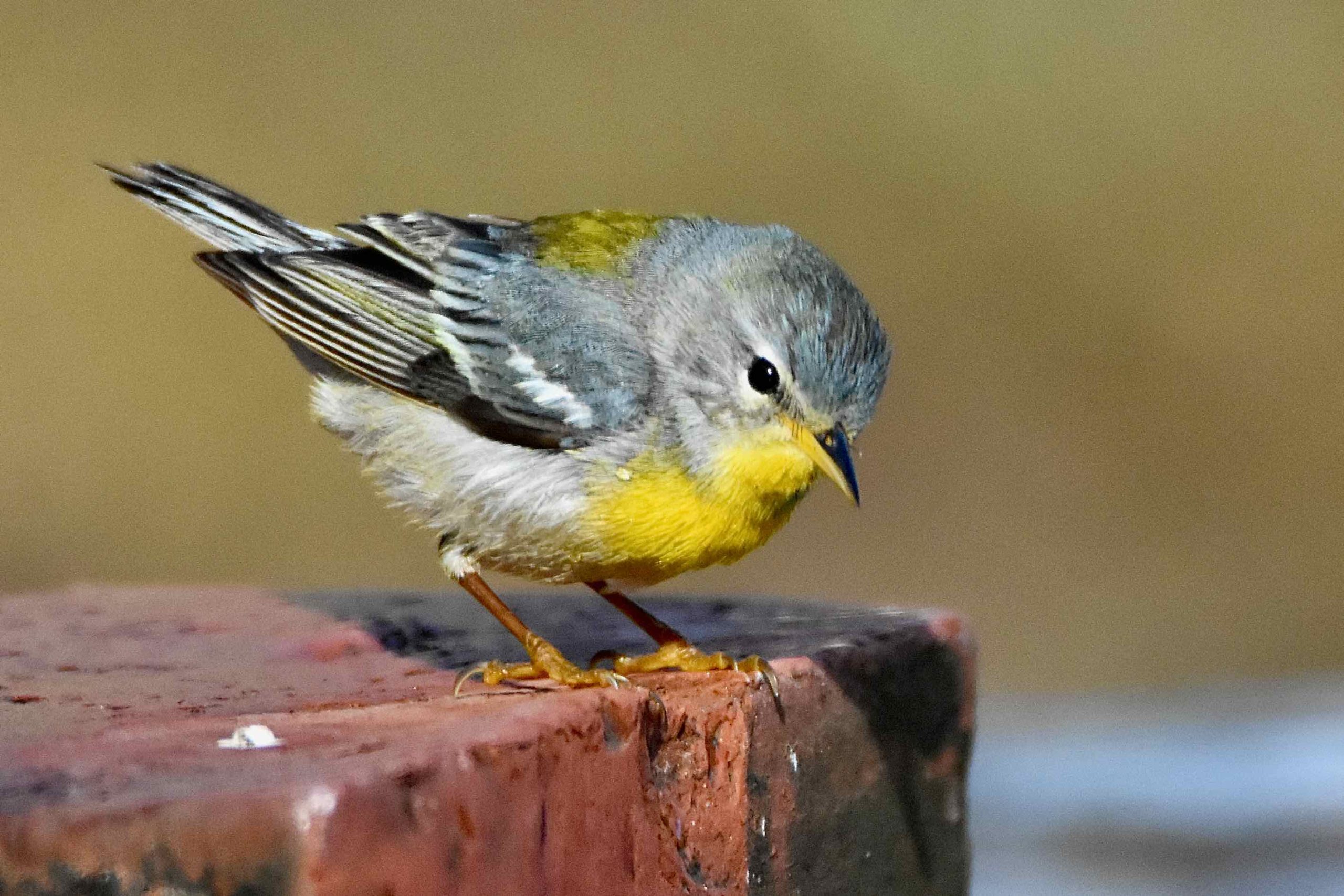Unlock the secrets of Tennessee’s warbler species with this comprehensive guide. Packed with vivid photo identification, captivating descriptions, enchanting audio recordings of their songs, and intriguing fun facts, this guide will help you become an expert on these lively migratory songbirds.
Warblers, those small and vibrant travelers, journey astonishing distances from the depths of South America to the far reaches of Canada, making Tennessee a crucial stopover on their path. These energetic creatures, adorned in brilliant shades of yellow and green, grace the woodlands and forests with their melodic symphonies.
Known as wood-warblers, these North American songbirds favor the sheltered embrace of woodland and forest habitats. Beware of warbler neck, a discomforting stiffness and tingling in the neck from gazing skyward through binoculars, attempting to spot these elusive creatures hidden among the treetops.
While warblers primarily dine on insects, they occasionally pay visits to backyard feeders, enticed by seeds and mealworms. Don’t miss out on the opportunity to learn about other bird species that frequent Tennessee, and don’t forget to grab a free identification chart.
Drawing on data collected from dedicated birdwatchers on ebird, as well as information sourced from Avibase, this guide unveils the regularly occurring warbler species in Tennessee, offering genuine insights into the optimal times for spotting these birds.
For each warbler featured in this guide, delight in the harmonies of their songs and explore the diverse repertoire of warbler vocalizations. Additionally, discover an auxiliary guide showcasing 13 easily recognizable warbler songs for further assistance.
Warblers in Tennessee by Season:
Summer Warblers in Tennessee: Common Yellowthroat, Northern Parula, Pine Warbler, Yellow-breasted Chat, Hooded Warbler, Yellow-throated Warbler, Black-and-white Warbler, Prothonotary Warbler, Prairie Warbler, Louisiana Waterthrush, Kentucky Warbler, Ovenbird, Yellow Warbler, Worm-eating Warbler, Cerulean Warbler, Swainson’s Warbler.
Winter Warblers in Tennessee: Yellow-rumped Warbler, Palm Warbler, Orange-crowned Warbler.
Migration Warblers in Tennessee: Black-throated Green Warbler, Tennessee Warbler, American Redstart, Magnolia Warbler, Chestnut-sided Warbler, Bay-breasted Warbler, Blackpoll Warbler, Blackburnian Warbler, Blue-winged Warbler, Nashville Warbler, Cape May Warbler, Northern Waterthrush, Canada Warbler, Black-throated Blue Warbler, Golden-winged Warbler, Wilson’s Warbler, Mourning Warbler, Connecticut Warbler.
37 Species of Warbler in Tennessee:
1. Yellow-rumped Warbler
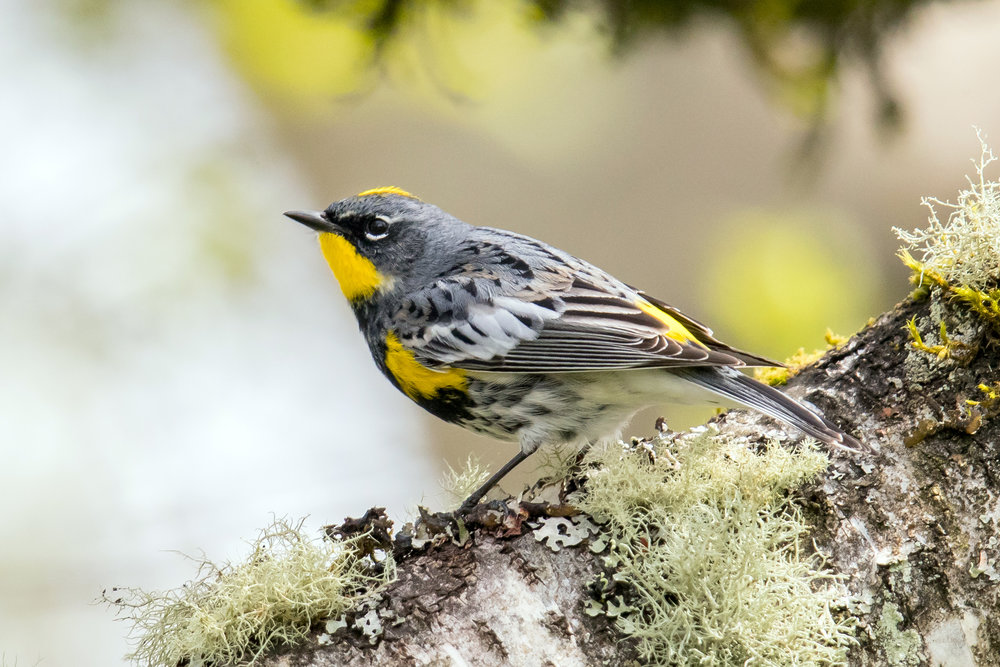
Observe the Yellow-rumped Warbler during its winter sojourn in Tennessee, spanning from October to May. This species appears in 21% of winter checklists submitted by vigilant birdwatchers.
Behold the Yellow-rumped Warbler, adorned in a delightful combination of gray plumage, accented by flashes of vibrant yellow on its face, sides, and rump, with wings boasting resplendent patches of white. Female individuals may exhibit a tinge of brown, while winter birds sport paler brown shades, donning bright yellow rumps and sides that transition to a captivating mix of yellow and gray with the advent of spring.
Two distinct subspecies of this warbler exist: the Myrtle Warbler, found in the eastern United States and the boreal forests of Canada, lacks the yellow throat, while Audubon’s Warbler, native to the western region, features more extensive white markings on its wings.
Scientific Name: Setophaga coronata
Length: 4.7-5.5 in (12-14 cm)
Weight: 0.4-0.5 oz (12-13 g)
Wingspan: 7.5-9.1 in (19-23 cm)
Yellow-rumped Warblers predominantly breed in Canada, gracing the Rocky Mountains and the Appalachian range with their presence.
Throughout their extensive migration, these avian travelers traverse the Midwest before settling in southern and southwestern states of the U.S., meandering along the Pacific Coast and venturing as far as Mexico and Central America.
Encounter Yellow-rumped Warblers in coniferous forests, particularly during the breeding season. During winter, they favor open areas teeming with fruit-bearing shrubs. Their diet consists mainly of insects during the summer and migratory periods, while fruits such as bayberry and wax myrtle sustain them during winter.
Immerse yourself in the melodious song of the Yellow-rumped Warbler, a mesmerizing chorus orchestrated by these enchanting creatures.
Fun Fact: During the winter months, Yellow-rumped Warblers assemble in flocks numbering in the thousands, displaying remarkable aggression toward other species that dare venture too close.
2. Common Yellowthroat

Embrace the presence of Common Yellowthroats during their breeding season, typically gracing Tennessee from April to October. These charming songbirds appear in 17% of summer checklists.
Discover the Common Yellowthroat, a diminutive avian adorned in a blend of brown hues adorning its back, contrasting beautifully with its radiant yellow underbelly. Sporting a graceful long tail, the males captivate with their distinctive black masks, signifying their masculinity. Geographically, the intensity of their yellow plumage varies, with some individuals presenting a more olive hue beneath their feathers.
Scientific Name: Geothlypis trichas
Length: 4.3-5.1 in (11-13 cm)
Weight: 0.3-0.3 oz (9-10 g)
Wingspan: 5.9-7.5 in (15-19 cm)
During the summer, Common Yellowthroats establish breeding grounds across the expanse of North America, save for Alaska and northern Canada. Some individuals remain year-round in the coastal regions along the Gulf Coast and the Pacific Southwest, while others embark on a southward migration for the winter.
Common Yellowthroats frequent marshy regions, wetlands, and brushy fields, where they frolic amidst thick, intertwined vegetation.
Immerse yourself in the enchanting melodies of the Common Yellowthroat, a testament to the beauty and complexity of their vocalizations.
Fun Fact: The presence of the black mask adorning the Common Yellowthroat’s countenance serves as a signal to courting males, inciting fierce attacks when decoy birds lacking this feature are introduced.
3. Northern Parula
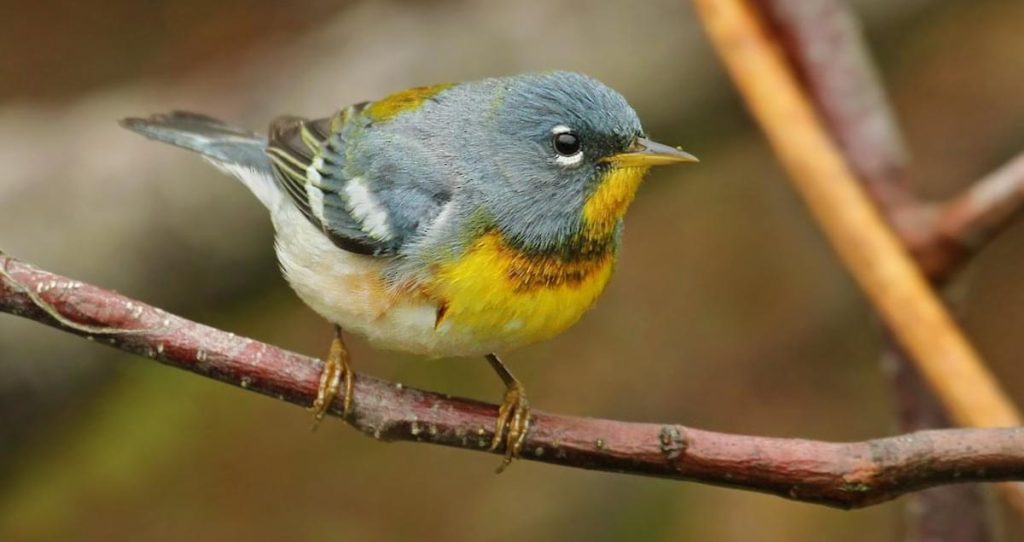
Witness the Northern Parula’s visitation to Tennessee during its breeding season, enchanting observers from late March to October. This captivating species graces approximately 13% of summer checklists.
Northern Parulas mesmerize with their vibrant combination of blueish-gray and yellow plumage. Their backs boast a captivating bluish-gray shade, adorned with a distinctive yellow patch, accompanied by two white wingbars.
Setophaga americana
Length: 4.3-4.7 in (11-12 cm)
Weight: 0.2-0.4 oz (5-11 g)
Wingspan: 6.3-7.1 in (16-18 cm)
Delighting the eastern United States and southeastern Canada with their presence during the breeding season, Northern Parulas embark on a migratory journey to Central America and the Caribbean for the winter. Some individuals choose to linger in the warmth of southern Florida throughout the colder months.
Spot these graceful birds as they forage high in the deciduous forests, indulging in their preferred diet of insects.
Immerse yourself in the melodious symphony of the Northern Parula, a testament to their awe-inspiring vocal talents.
Fun Fact: In the intricate world of Northern Parula parenting, females assume the responsibility of rearing the young, diligently incubating the eggs and providing nourishment. Meanwhile, males engage in serenades, removing fecal sacs to maintain the nest’s cleanliness.
4. Pine Warbler
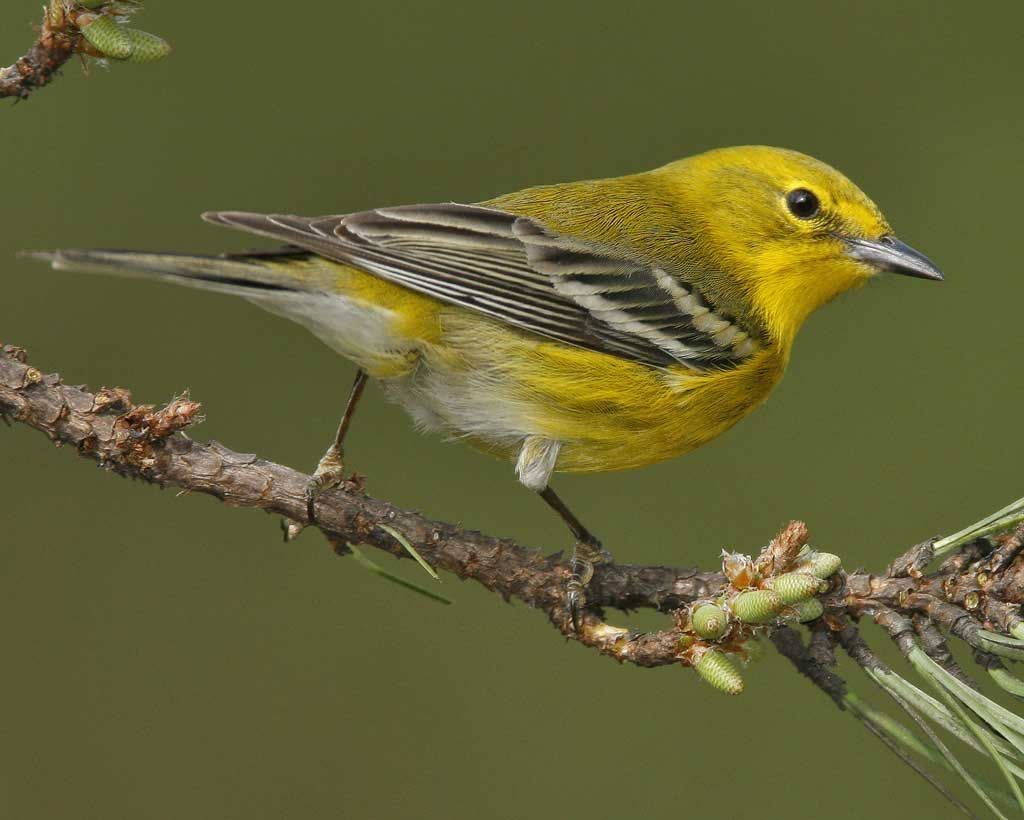
Marvel at the Pine Warbler’s presence in Tennessee, gracing the state year-round, with higher concentrations observed from March to June. These delightful creatures illuminate approximately 4% of summer and winter checklists.
Pine Warblers captivate with their plump and cheerful appearance, adorned in vibrant shades of yellow. Their olive backs complement the white lower bellies, while subtle gray wingbars add a touch of elegance. Female individuals may exhibit a hint of brown, accompanied by additional white patches on the belly.
Setophaga pinus
Length: 5.1-5.5 in (13-14 cm)
Weight: 0.3-0.5 oz (9-15 g)
Wingspan: 7.5-9.1 in (19-23 cm)
Thriving in the northeastern states of the U.S., Pine Warblers journey to the southeastern regions during the winter, with some individuals opting for a permanent residency in the warm embrace of southeastern states.
Discover Pine Warblers amidst pine forests, their natural habitat, often perched high in the trees. These delightful warblers savor a diet consisting of caterpillars, beetles, spiders, and other insects. In colder weather, they supplement their sustenance with the consumption of fruits and seeds.
Dive into the delightful chorus of the Pine Warbler, a celebration of nature’s symphony.
Fun Fact: Pine Warblers deviate from their warbler peers by exhibiting a primary preference for seeds, making them frequent visitors to backyard feeders.
5. Yellow-breasted Chat
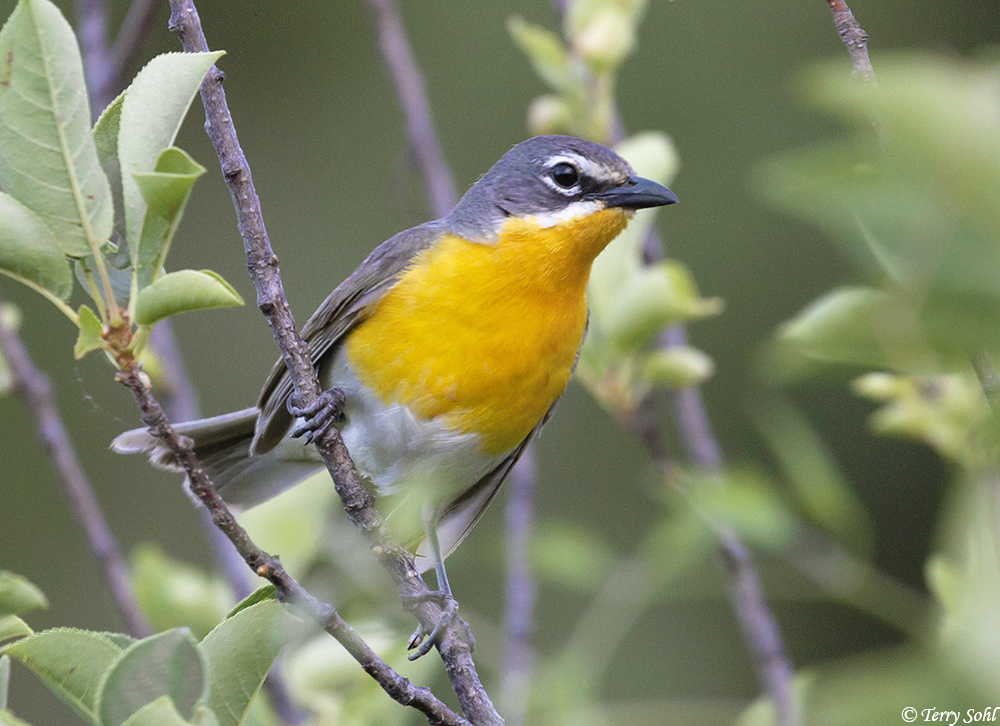
Embrace the arrival of the Yellow-breasted Chat during the Tennessee summer, gracing the state from April to September, enchanting observers in approximately 13% of checklists during this period.
Yellow-breasted Chats exude an aura of charm, featuring bright yellow breasts and elegant long tails. Their olive-gray backs harmonize with gray heads, accentuated by captivating white markings around the eyes and chin. Their lower bellies shimmer in pristine white.
Icteria virens
Length: 7.1 in (18 cm)
Weight: 0.8-1.1 oz (23-31 g)
Wingspan: 9.8 in (25 cm)
The Yellow-breasted Chat’s breeding grounds encompass most U.S. states, extending into southern regions of Canada. As winter approaches, these captivating creatures embark on a journey to Central America and coastal Mexico.
Spot Yellow-breasted Chats amidst blackberry bushes, fields, and forest edges, as they indulge in a varied diet of spiders, insects, and delectable berries.
Immerse yourself in the mesmerizing melodies of the Yellow-breasted Chat, a testament to their avian artistry.
Fun Fact: Male Yellow-breasted Chats engage in aerial grappling matches, utilizing their feet, while performing a dramatic flight display accompanied by their captivating songs. These performances culminate with a thrilling thump of their wings as they gracefully touch the ground.
6. Black-throated Green Warbler

The Black-throated Green Warbler graces Tennessee during the spring and fall migration, with some individuals also choosing to spend their breeding season in the state.
Black-throated Green Warblers captivate with their small, yellow bodies adorned with a striking yellow face and head, complemented by an olive-yellow back. They showcase black streaking on the sides and wings, while their underbellies radiate a whitish hue. Male individuals proudly display large black patches on their throats, distinguishing them from their female and juvenile counterparts.
Setophaga virens
Length: 4.3-4.7 in (11-12 cm)
Weight: 0.3-0.4 oz (7-11 g)
Wingspan: 6.7-7.9 in (17-20 cm)
Embarking on a remarkable migratory journey across the eastern United States, Black-throated Green Warblers settle in northeastern states and Canada for their breeding season. Their winter grounds extend to Mexico, northern South America, and the Caribbean.
Discover Black-throated Green Warblers high up in forests, where they diligently hunt for insects. The distinctive black throat serves as a distinguishing feature from other small yellow birds.
Let the enchanting melodies of the Black-throated Green Warbler captivate your senses, a true testament to the beauty of their songs.
Fun Fact: Male Black-throated Green Warblers are known for their remarkable singing prowess, often delivering over 400 songs in a single hour. They engage in a captivating “gloating” flight display, celebrating their victories over rivals.
7. Hooded Warbler
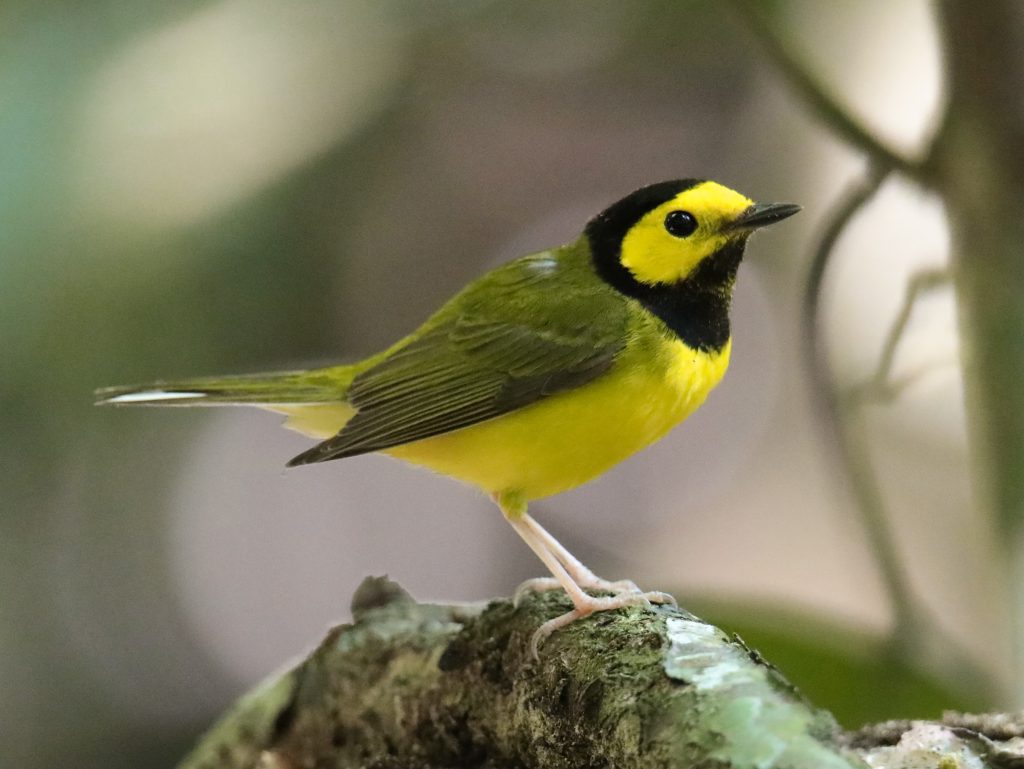
The Hooded Warbler chooses Tennessee as its breeding grounds, delighting observers from mid-March until October. Approximately 7% of summer checklists are graced by their presence.
Male Hooded Warblers emanate an air of elegance with their bright yellow faces, adorned by a distinctive black hood and throat. Their yellow underbellies blend harmoniously with their olive-green backs. Notably, their white tail feathers peek through when they excitedly flick their tails.
Setophaga citrina
Length: 5.1 in (13 cm)
Weight: 0.3-0.4 oz (9-12 g)
Wingspan: 6.9 in (17.5 cm)
Hooded Warblers establish their breeding grounds in eastern U.S. states before embarking on a journey southward to Central America and the Caribbean for the winter months.
Spot these charismatic warblers in forests boasting dense understories, where they expertly navigate the thick vegetation in search of insects and spiders.
Indulge in the captivating melodies of the Hooded Warbler, a testament to their artistry in song.
Fun Fact: Hooded Warblers possess white spots on their tails, which serve the purpose of startling insects, enabling them to catch their prey more easily.
8. Yellow-throated Warbler
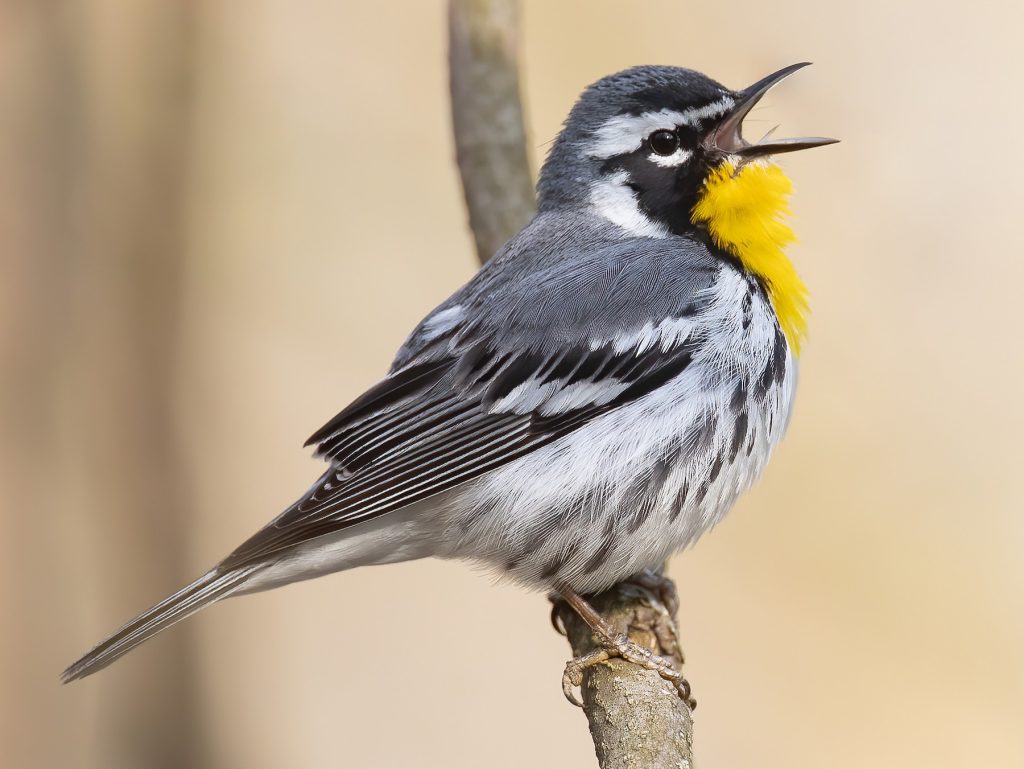
Yellow-throated Warblers grace Tennessee during their breeding season, enchanting observers from approximately April to September. They appear in 7% of summer checklists.
Yellow-throated Warblers present a striking blend of gray and white, accentuated by black stripes and bright yellow throats. Their white bellies and tails add a touch of elegance. Female and juvenile individuals showcase a paler coloration.
Setophaga dominica
Length: 5.1-5.5 in (13-14 cm)
Weight: 0.3-0.4 oz (9-11 g)
Wingspan: 8.3 in (21 cm)
Thriving across southeastern U.S. states, Yellow-throated Warblers embark on a winter migration journey
to Florida, the Caribbean, and the Gulf Coast, extending into Central America. Some individuals opt to remain year-round residents in Florida.
Discover Yellow-throated Warblers high up in pine trees, as they deftly search for insects. During migration, they may forage at lower heights.
Immerse yourself in the captivating songs of the Yellow-throated Warbler, a true delight for bird enthusiasts.
Fun Fact: Yellow-throated Warblers have experienced a remarkable increase in population in recent years. Despite previous declines and range contractions, their numbers have surged by 50% since 1966.
9. Black-and-white Warbler
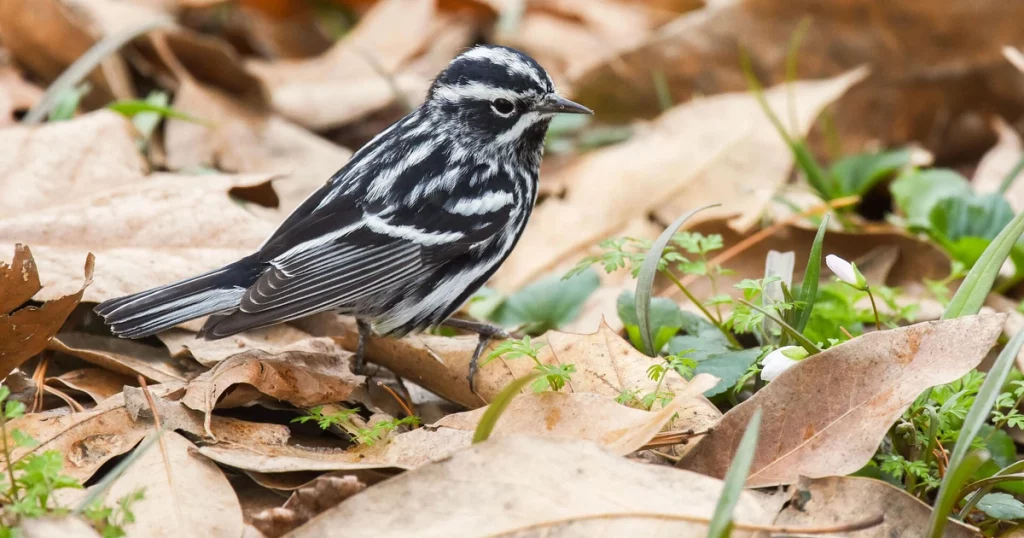
The Black-and-white Warbler graces Tennessee during its breeding season, but their numbers surge during migration. They appear in 6% of summer checklists and up to 12% of checklists during migration.
Black-and-white Warblers exhibit a distinct appearance, making them easily recognizable. Males showcase a large black patch that extends across the eye and cheek, with a darker black coloration compared to females.
Mniotilta varia
Length: 4.3-5.1 in (11-13 cm)
Weight: 0.3-0.5 oz (8-15 g)
Wingspan: 7.1-8.7 in (18-22 cm)
These delightful warblers establish breeding grounds across the eastern United States and Canada. During winter, they migrate to regions encompassing Florida, the Gulf Coast, Mexico, Baja California, the Caribbean, and northern South America. Their migration path includes central states of the U.S.
Discover Black-and-white Warblers as they hop up and down tree trunks and branches in forested areas, diligently foraging for insects.
Immerse yourself in the enchanting melodies of the Black-and-white Warbler, adding a harmonious touch to nature’s grand orchestra.
Fun Fact: Black-and-white Warblers prefer nesting on or near the ground, often concealed beneath logs or shrubs. Their nests consist of bark, grass, and pine needles intricately woven into a cup shape.
10. Tennessee Warbler

The Tennessee Warbler graces Tennessee during its migratory journeys, enchanting observers from April to May and August to November. During the spring migration, they appear in approximately 15% of checklists, while during the fall migration, they make an appearance in 24% of checklists.
Tennessee Warblers exhibit a charming appearance, with males showcasing gray heads and green backs, while females don a greener plumage with yellow undertones. Males feature a white eyestripe, while females boast a yellow eyestripe. The underparts of both genders exhibit a pristine white coloration.
Leiothlypis peregrina
Length: 3.9-5.1 in (10-13 cm)
Weight: 0.3-0.3 oz (8-10 g)
Wingspan: 7.5-7.9 in (19-20 cm)
These avian wanderers embark on a remarkable journey from Central America, traversing up to Canada. During their migratory flights, they can be spotted across eastern U.S. states.
Spot Tennessee Warblers as they diligently forage for caterpillars on trees and shrubs in woodlands, showcasing their remarkable agility.
Indulge in the enchanting melodies of the Tennessee Warbler, a testament to their migratory spirit and vocal prowess.
Fun Fact: Despite its name, the Tennessee Warbler does not breed or spend significant time in Tennessee. The species was named after the state, as it was initially discovered there.
11. American Redstart
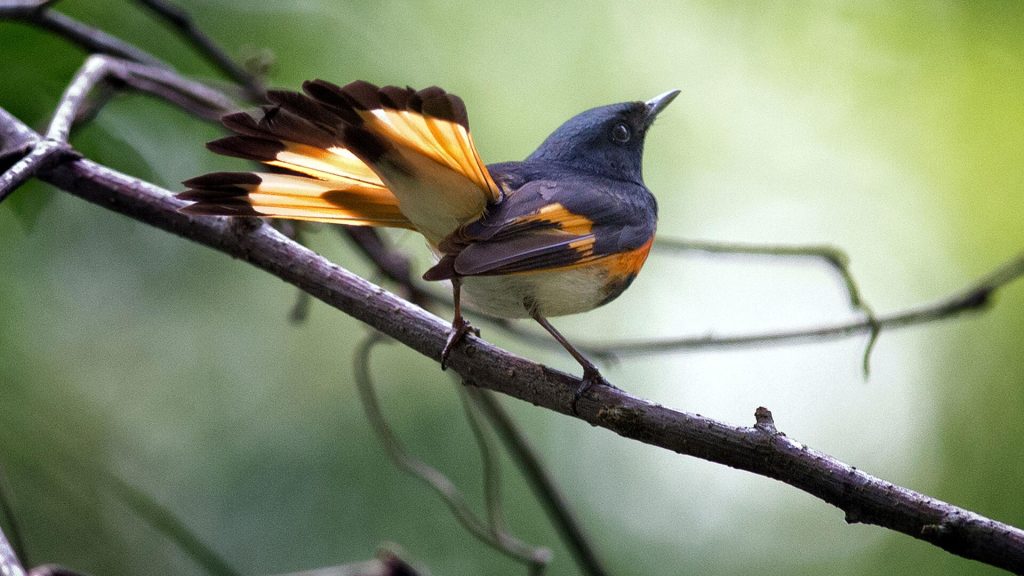
The American Redstart makes a captivating appearance in Tennessee during its migratory journeys. They grace the state with their presence during the spring and fall migrations.
American Redstarts showcase a striking plumage, with males exhibiting jet black feathers interspersed with vibrant orange patches on their wings, tail, and sides. Females, on the other hand, boast a more subdued appearance, with grayish-green upperparts and yellowish underparts.
Setophaga ruticilla
Length: 4.3-5.1 in (11-13 cm)
Weight: 0.3-0.4 oz (8-11 g)
Wingspan: 7.5-8.3 in (19-21 cm)
These migratory wonders undertake an extensive journey, breeding in northeastern North America and venturing as far south as Central America for the winter.
Witness the mesmerizing aerial displays of American Redstarts as they flit through the forest canopy, showcasing their agility in pursuit of insects.
Immerse yourself in the melodious songs of the American Redstart, a harmonious addition to the chorus of migratory songbirds.
Fun Fact: The American Redstart is known for its unique foraging behavior called “startle-feeding.” They rapidly spread their wings and tail, revealing their vibrant orange patches, which startles insects and makes them easier to catch.
12. Magnolia Warbler

The Magnolia Warbler graces Tennessee with its presence during its migratory journeys, making an appearance during the spring and fall migrations.
Magnolia Warblers showcase a captivating combination of black, yellow, and white plumage. Males feature a black mask across their faces, complemented by a striking yellow throat, chest, and underparts. Their wings and back exhibit a bold black and white pattern. Females possess a more subdued appearance with grayish-green upperparts and yellow underparts.
Setophaga magnolia
Length: 4.3-5.1 in (11-13 cm)
Weight: 0.3-0.4 oz (8-11 g)
Wingspan: 7.5-8.3 in (19-21 cm)
These migratory beauties
breed in the boreal forests of Canada and northeastern United States before embarking on a remarkable journey to their wintering grounds in Mexico, Central America, and the Caribbean.
Spot Magnolia Warblers as they flit through the trees, diligently foraging for insects in the forest canopy.
Indulge in the delightful songs of the Magnolia Warbler, adding a melodic touch to the natural symphony.
Fun Fact: The Magnolia Warbler was named by famed ornithologist Alexander Wilson, who described it as resembling the magnolia flower due to its yellow and black coloration.
13. Chestnut-sided Warbler
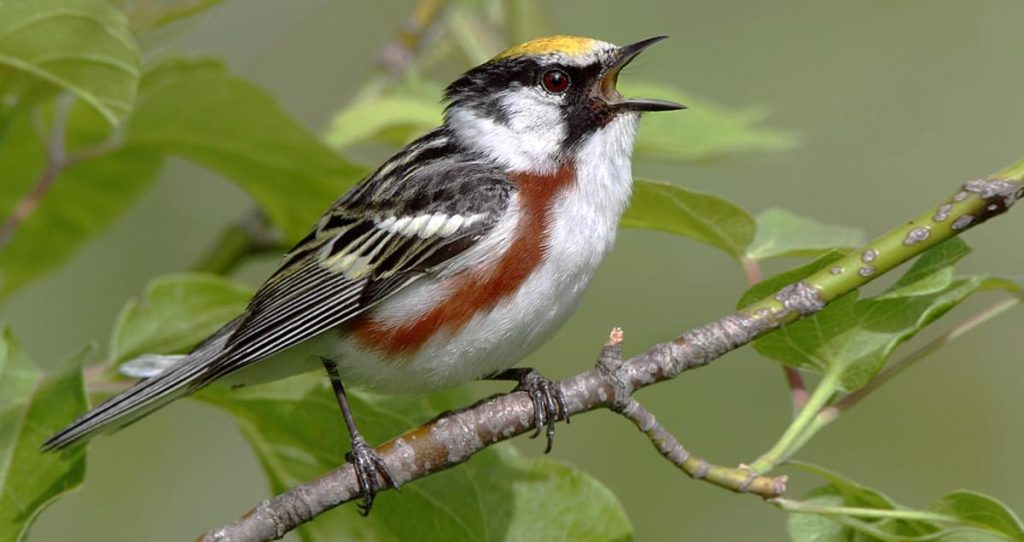
The Chestnut-sided Warbler graces Tennessee during its migratory journeys, captivating observers during the spring and fall migrations.
Chestnut-sided Warblers showcase a striking blend of yellow, chestnut, and white plumage. Males feature bright yellow underparts and a distinctive chestnut patch on their sides. Their crowns and backs exhibit a combination of olive-green and gray, creating a captivating contrast. Females possess a more subdued appearance with a pale yellow hue and less prominent chestnut patches.
Setophaga pensylvanica
Length: 4.3-5.1 in (11-13 cm)
Weight: 0.3-0.4 oz (8-11 g)
Wingspan: 7.5-8.3 in (19-21 cm)
These migratory songbirds breed in the northern United States and Canada before embarking on a journey to their wintering grounds in Mexico, Central America, and the Caribbean.
Spot Chestnut-sided Warblers amidst shrubby areas and young forests, as they expertly navigate through the foliage in search of insects.
Immerse yourself in the delightful songs of the Chestnut-sided Warbler, a true testament to their musical prowess.
Fun Fact: The distinctive chestnut-colored patches on the sides of male Chestnut-sided Warblers led to their common name. It resembles the coloration of chestnuts, adding to their unique charm.
14. Bay-breasted Warbler

The Bay-breasted Warbler graces Tennessee during its migratory journeys, making a striking appearance during the spring and fall migrations.
Bay-breasted Warblers showcase a captivating blend of pinkish-brown and gray plumage. Males feature a prominent reddish-brown crown, complemented by a gray face and underparts. Their flanks and sides exhibit a delicate pinkish hue. Females possess a more subdued appearance with a pale yellow hue and less prominent reddish-brown crown.
Setophaga castanea
Length: 4.3-5.1 in (11-13 cm)
Weight: 0.3-0.4 oz (8-11 g)
Wingspan: 7.5-8.3 in (19-21 cm)
These migratory wonders breed in the boreal forests of Canada and northeastern United States before embarking on a remarkable journey to their wintering grounds in Central and northern South America.
Spot Bay-breasted Warblers as they flit through the trees, often foraging in the upper canopy for insects.
Immerse yourself in the melodic songs of the Bay-breasted Warbler, adding a harmonious touch to the avian chorus.
Fun Fact: The Bay-breasted Warbler has a unique feeding behavior called “gleaning.” They meticulously search leaves and branches for insects, showcasing their skillful foraging techniques.
15. Blackpoll Warbler

The Blackpoll Warbler graces Tennessee during its migratory journeys, making a striking appearance during the spring and fall migrations.
Blackpoll Warblers exhibit a captivating contrast of black and white plumage. Males showcase a bold black cap and face, accompanied by a white underbody. Their wings
and back exhibit a striking black and white pattern. Females possess a more subdued appearance with a grayish-green upperbody and a pale yellow hue on their underparts.
Setophaga striata
Length: 4.3-5.1 in (11-13 cm)
Weight: 0.3-0.4 oz (8-11 g)
Wingspan: 7.5-8.3 in (19-21 cm)
These migratory wonders breed in the boreal forests of Canada and northeastern United States before embarking on an incredible journey to their wintering grounds in northern South America.
Spot Blackpoll Warblers as they navigate through the trees, foraging for insects high up in the canopy.
Indulge in the melodic songs of the Blackpoll Warbler, a delightful addition to the chorus of migratory songbirds.
Fun Fact: The Blackpoll Warbler is known for its remarkable long-distance migration, with some individuals undertaking non-stop flights of over 2,000 miles across the Atlantic Ocean to reach their wintering grounds in South America.
16. Blackburnian Warbler
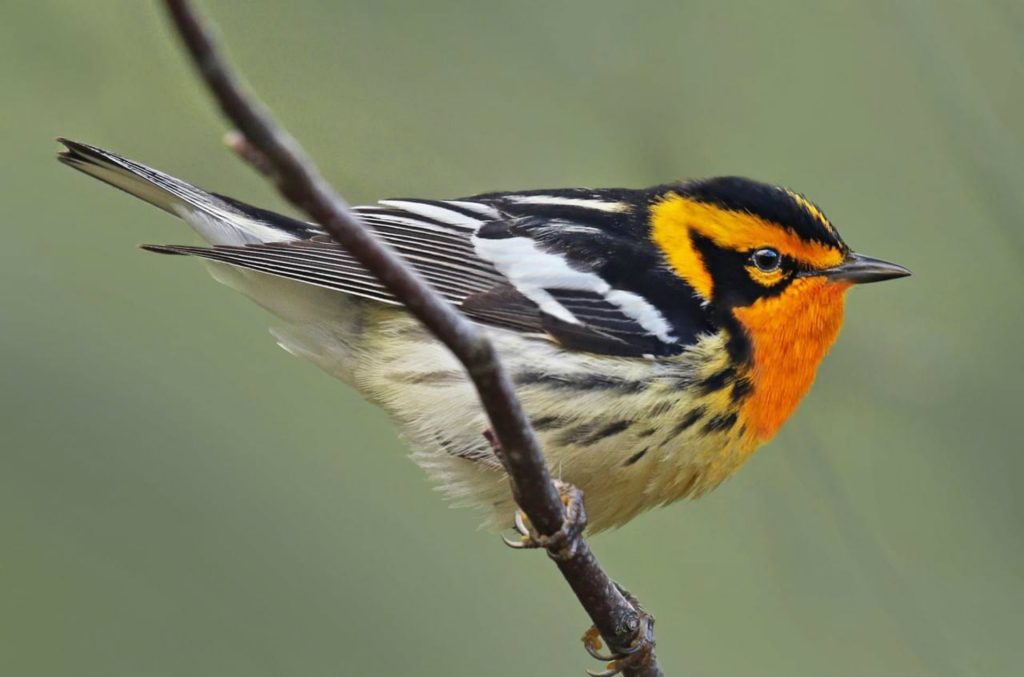
The Blackburnian Warbler graces Tennessee during its migratory journeys, enchanting observers with its vibrant appearance during the spring and fall migrations.
Blackburnian Warblers showcase a captivating blend of fiery orange and black plumage. Males feature a vibrant orange throat and breast, contrasted by a black back and wings. Their crown exhibits a stunning combination of black and orange. Females possess a more subdued appearance with a yellow hue on their throat and breast.
Setophaga fusca
Length: 4.3-5.1 in (11-13 cm)
Weight: 0.3-0.4 oz (8-11 g)
Wingspan: 7.5-8.3 in (19-21 cm)
These migratory wonders breed in the boreal forests of Canada and northeastern United States before embarking on a remarkable journey to their wintering grounds in Central and northern South America.
Spot Blackburnian Warblers amidst the upper canopy of coniferous and mixed forests, as they diligently search for insects.
Immerse yourself in the melodious songs of the Blackburnian Warbler, a true delight for bird enthusiasts.
Fun Fact: The vibrant orange throat and breast of the Blackburnian Warbler led to its specific epithet “fusca,” which means “dark” in Latin, highlighting the stunning contrast in its plumage.
17. Blue-winged Warbler
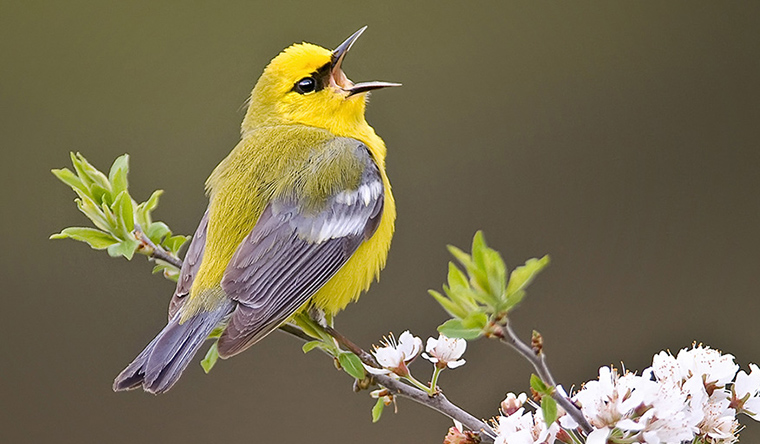
The Blue-winged Warbler graces Tennessee during its migratory journeys, making a striking appearance during the spring and fall migrations.
Blue-winged Warblers exhibit a captivating combination of yellow and blue plumage. Males feature a vibrant yellow body, complemented by striking blue-gray wings and tail. Females possess a similar yellow hue but lack the blue-gray wings.
Vermivora cyanoptera
Length: 4.3-5.1 in (11-13 cm)
Weight: 0.3-0.4 oz (8-11 g)
Wingspan: 7.5-8.3 in (19-21 cm)
These migratory wonders breed in the eastern United States before embarking on a journey to their wintering grounds in Central America and northern South America.
Spot Blue-winged Warblers in shrubby habitats, including woodland edges and regenerating forests, as they forage for insects and spiders.
Indulge in the delightful songs of the Blue-winged Warbler, adding a harmonious touch to the natural symphony.
Fun Fact: The Blue-winged Warbler often hybridizes with the Golden-winged Warbler, resulting in unique hybrid offspring known as “Brewster’s Warbler” and “Lawrences Warbler.”
18. Nashville Warbler
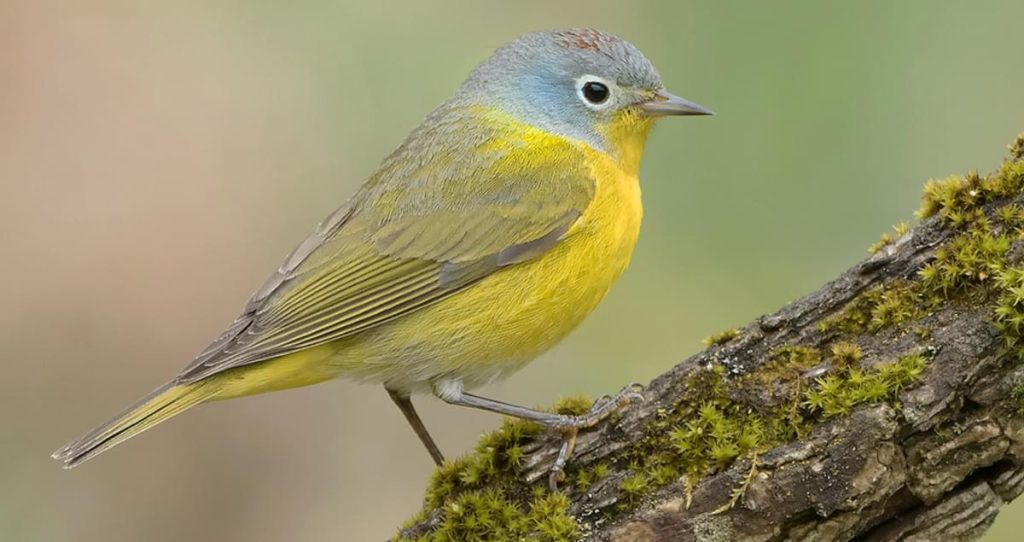
The Nashville Warbler graces Tennessee during its migratory journeys, captivating observers with its appearance during the spring and fall migrations.
Nashville Warblers showcase a charming combination of yellow and gray plumage. Males feature a vibrant yellow throat, breast, and underparts, contrasted by a gray back and wings. Females possess a similar yellow hue but with a paler gray coloration on their upperparts.
Leiothlypis ruficapilla
Length: 4.3-5.1 in (11-13 cm)
Weight: 0.3-0.4 oz (8-11 g)
Wingspan: 7.5-8.3 in (19-21 cm)
These migratory songbirds breed in the boreal forests of Canada and northeastern United States before embarking on a journey to their wintering grounds in Central America.
Spot Nashville Warblers in forested habitats, particularly coniferous and mixed forests, as they actively forage for insects.
Immerse yourself in the melodious songs of the Nashville Warbler, a delightful addition to the avian chorus.
Fun Fact: The Nashville Warbler was named after Nashville, Tennessee, as the species was first collected and described there during the 19th century.
19. Cape May Warbler

The Cape May Warbler graces Tennessee during its migratory journeys, captivating observers with its striking appearance during the spring and fall migrations.
Cape May Warblers exhibit a captivating blend of yellow, black, and chestnut plumage. Males feature a vibrant yellow throat, chest, and underparts, contrasted by a black-streaked back and wings. Their heads showcase a unique combination of chestnut, black, and yellow. Females possess a more subdued appearance with less prominent chestnut and black markings.
Setophaga tigrina
Length: 4.3-5.1 in (11-13 cm)
Weight: 0.3-0.4 oz (8-11 g)
Wingspan: 7.5-8.3 in (19-21 cm)
These migratory wonders breed in the boreal forests of Canada before embarking on a remarkable journey to their wintering grounds in the Caribbean and northern South America.
Spot Cape May Warblers in various habitats, including coniferous forests and forest edges, as they diligently forage for insects, particularly nectar from flowering trees.
Indulge in the melodious songs of the Cape May Warbler, a true delight for bird enthusiasts.
Fun Fact: The Cape May Warbler is known for its unique feeding behavior. During migration, they have a fondness for sipping nectar from flowering trees, using their specialized tongue to extract the sweet liquid.
20. Northern Waterthrush
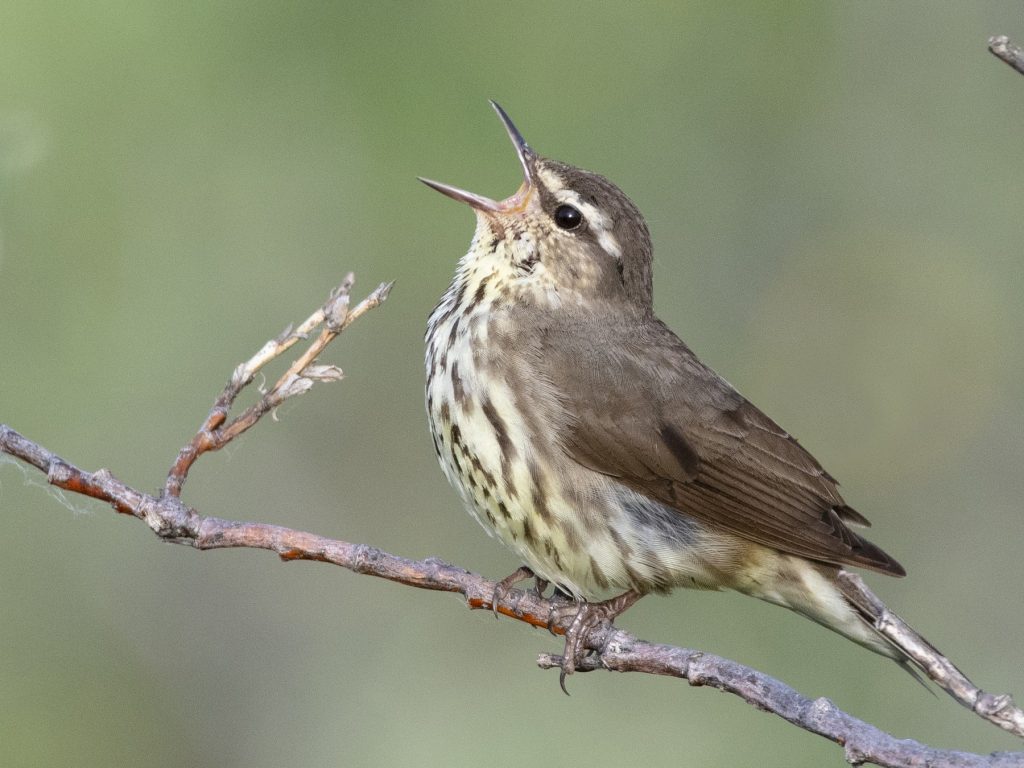
The Northern Waterthrush graces Tennessee during its migratory journeys, captivating observers with its presence during the spring and fall migrations.
Northern Waterthrushes showcase a charming combination of brown and white plumage. They exhibit a streaked brown back, complemented by a white belly and flanks. Their underparts exhibit bold brown streaks on a white background.
Parkesia noveboracensis
Length: 4.7-5.1 in (12-13 cm)
Weight: 0.3-0.4 oz (9-11 g)
Wingspan: 7.5-8.3 in (19-21 cm)
These migratory songbirds breed in the northern United States and Canada before embarking on a journey to their wintering grounds in the Caribbean, Central America, and northern South America.
Spot Northern Waterthrushes near wetland habitats, including marshes, streams, and forested sw
amps, as they forage along the water’s edge for insects and aquatic invertebrates.
Immerse yourself in the melodious songs of the Northern Waterthrush, reminiscent of the babbling brooks that dot their preferred habitats.
Fun Fact: The Northern Waterthrush is not actually a thrush but belongs to the warbler family. Its name is derived from its habit of foraging along the water’s edge, resembling the behavior of a thrush.
21. Canada Warbler
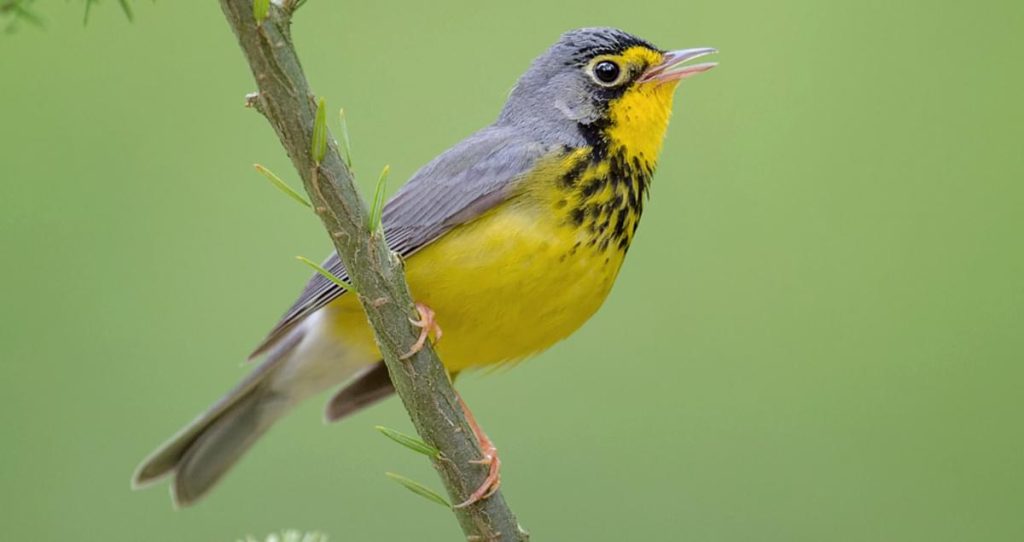
The Canada Warbler graces Tennessee during its migratory journeys, enchanting observers with its appearance during the spring and fall migrations.
Canada Warblers showcase a striking combination of yellow and gray plumage. Males feature a vibrant yellow throat and breast, contrasted by a gray back and wings. Their crowns exhibit a stunning combination of black and gray. Females possess a more subdued appearance with a pale yellow hue on their underparts.
Cardellina canadensis
Length: 4.3-5.1 in (11-13 cm)
Weight: 0.3-0.4 oz (8-11 g)
Wingspan: 7.5-8.3 in (19-21 cm)
These migratory wonders breed in the boreal forests of Canada before embarking on an incredible journey to their wintering grounds in northern South America.
Spot Canada Warblers in dense shrubby habitats near wetlands, as they diligently search for insects and larvae.
Indulge in the melodious songs of the Canada Warbler, a beautiful addition to the chorus of migratory songbirds.
Fun Fact: The Canada Warbler is known for its unique behavior of flipping over leaves to uncover hidden insects, earning it the nickname “Necklaced Warbler” due to the distinctive black “necklace” pattern on its throat.
22. Black-throated Blue Warbler
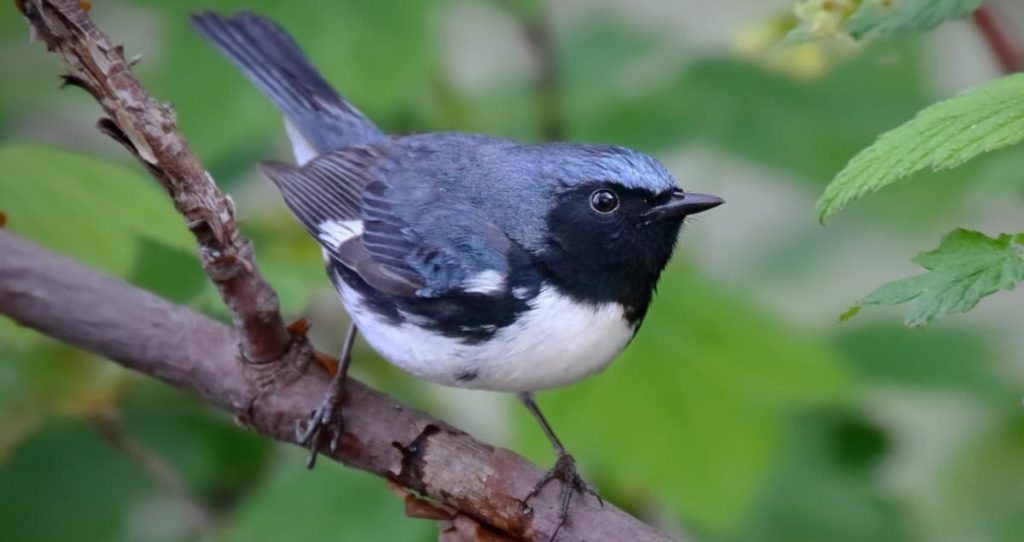
The Black-throated Blue Warbler graces Tennessee during its migratory journeys, captivating observers with its striking appearance during the spring and fall migrations.
Black-throated Blue Warblers exhibit a captivating combination of black, blue, and white plumage. Males feature a vibrant blue back and wings, contrasted by a black throat and face. Their underparts are white. Females possess a more subdued appearance with a grayish-olive hue on their upperparts and a pale yellow hue on their underparts.
Setophaga caerulescens
Length: 4.7-5.1 in (12-13 cm)
Weight: 0.3-0.4 oz (8-11 g)
Wingspan: 7.5-8.3 in (19-21 cm)
These migratory wonders breed in the northeastern United States and southeastern Canada before embarking on a journey to their wintering grounds in the Caribbean and northern South America.
Spot Black-throated Blue Warblers in various habitats, including deciduous and mixed forests, as they actively forage for insects, often gleaning them from leaves and branches.
Immerse yourself in the melodious songs of the Black-throated Blue Warbler, adding a harmonious touch to the avian chorus.
Fun Fact: Male Black-throated Blue Warblers exhibit a unique behavior known as “extra-pair mating.” They engage in extramarital courtship and breeding with other females while still maintaining their original pair bond.
23. Golden-winged Warbler
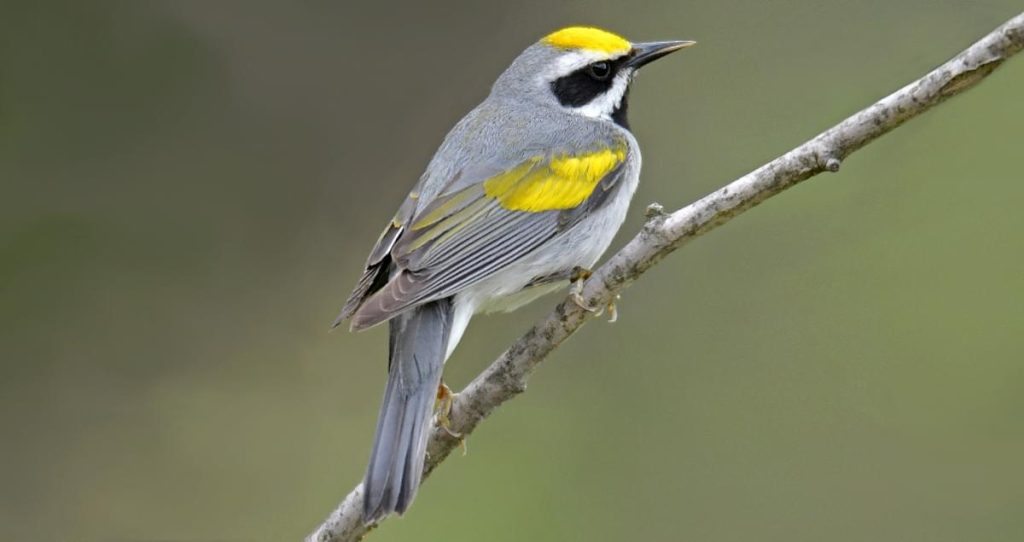
The Golden-winged Warbler graces Tennessee during its migratory journeys, enchanting observers with its appearance during the spring and fall migrations.
Golden-winged Warblers showcase a captivating combination of yellow and gray plumage. Males feature a vibrant yellow head and underparts, contrasted by a gray back and wings. Their wings exhibit a distinctive golden patch. Females possess a more subdued appearance with a paler yellow hue on their underparts.
Vermivora chrysoptera
Length: 4.3-4.7 in (11-12 cm)
Weight: 0.3-0.4 oz (8-11 g)
Wingspan: 7.1-7.9 in (18-20 cm)
These migratory wonders breed in the northeastern
United States and Canada before embarking on an incredible journey to their wintering grounds in Central and northern South America.
Spot Golden-winged Warblers in shrubby habitats, including young forests and regenerating clearcuts, as they diligently forage for insects and spiders.
Indulge in the melodious songs of the Golden-winged Warbler, a true delight for bird enthusiasts.
Fun Fact: The Golden-winged Warbler is known for its propensity to hybridize with the Blue-winged Warbler, resulting in unique hybrid offspring known as “Brewster’s Warbler” and “Lawrence’s Warbler.”
24. Wilson’s Warbler

The Wilson’s Warbler graces Tennessee during its migratory journeys, captivating observers with its presence during the spring and fall migrations.
Wilson’s Warblers showcase a charming combination of yellow and olive plumage. Males feature a vibrant yellow cap and underparts, contrasted by olive-green wings and back. Their faces exhibit a distinctive black crown. Females possess a more subdued appearance with a paler yellow hue on their underparts and a grayish-olive coloration on their upperparts.
Cardellina pusilla
Length: 4.3-4.7 in (11-12 cm)
Weight: 0.3-0.4 oz (8-11 g)
Wingspan: 7.5-8.3 in (19-21 cm)
These migratory songbirds breed in the western United States and Canada before embarking on a journey to their wintering grounds in Central America and northern South America.
Spot Wilson’s Warblers in various habitats, including deciduous and mixed forests, as they actively forage for insects, often hopping along the forest floor and low branches.
Immerse yourself in the melodious songs of the Wilson’s Warbler, adding a harmonious touch to the avian chorus.
Fun Fact: The Wilson’s Warbler is named after Alexander Wilson, a Scottish-American ornithologist who is often referred to as the “father of American ornithology.”
25. Mourning Warbler
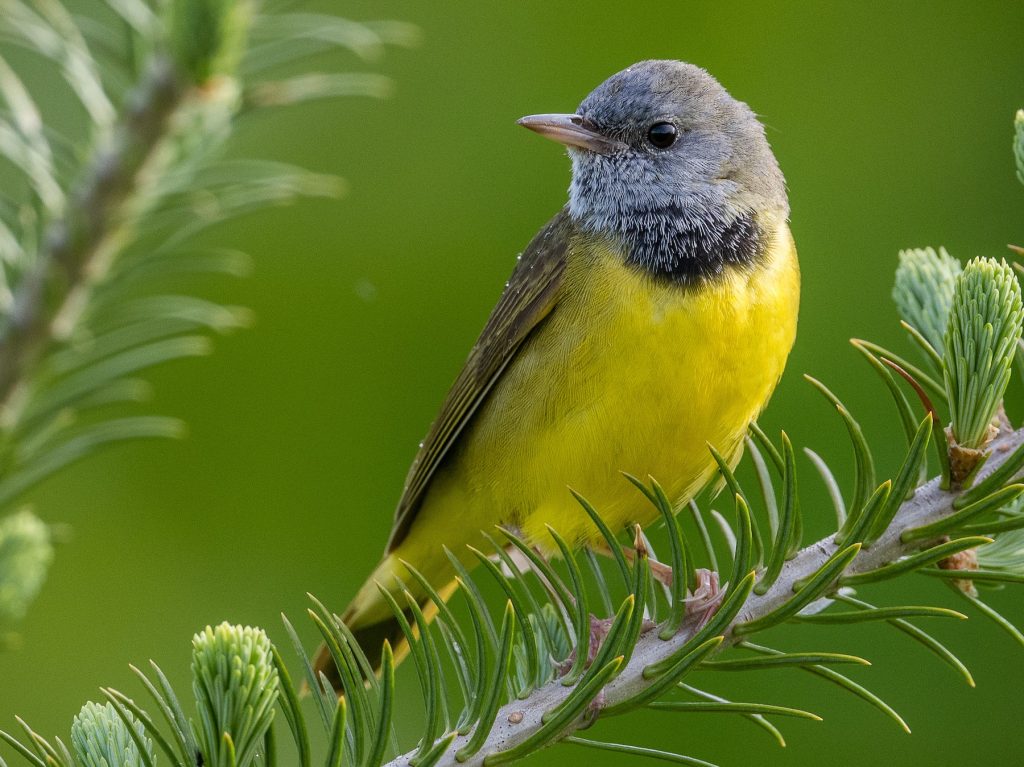
The Mourning Warbler graces Tennessee during its migratory journeys, enchanting observers with its appearance during the spring and fall migrations.
Mourning Warblers exhibit a charming combination of olive and yellow plumage. Males feature an olive-green head, back, and wings, contrasted by a bright yellow throat and underparts. Their faces exhibit a distinctive black mask. Females possess a more subdued appearance with a paler yellow hue on their underparts and a grayish-olive coloration on their upperparts.
Geothlypis philadelphia
Length: 4.3-4.7 in (11-12 cm)
Weight: 0.3-0.4 oz (8-11 g)
Wingspan: 7.5-8.3 in (19-21 cm)
These migratory wonders breed in the northeastern United States and Canada before embarking on an incredible journey to their wintering grounds in Central and northern South America.
Spot Mourning Warblers in shrubby habitats, including young forests, regenerating clearcuts, and wetland edges, as they diligently search for insects and caterpillars.
Indulge in the melodious songs of the Mourning Warbler, a true delight for bird enthusiasts.
Fun Fact: The Mourning Warbler is named after its melancholic-sounding song, which resembles the sound of mourning or lamentation.
26. Connecticut Warbler
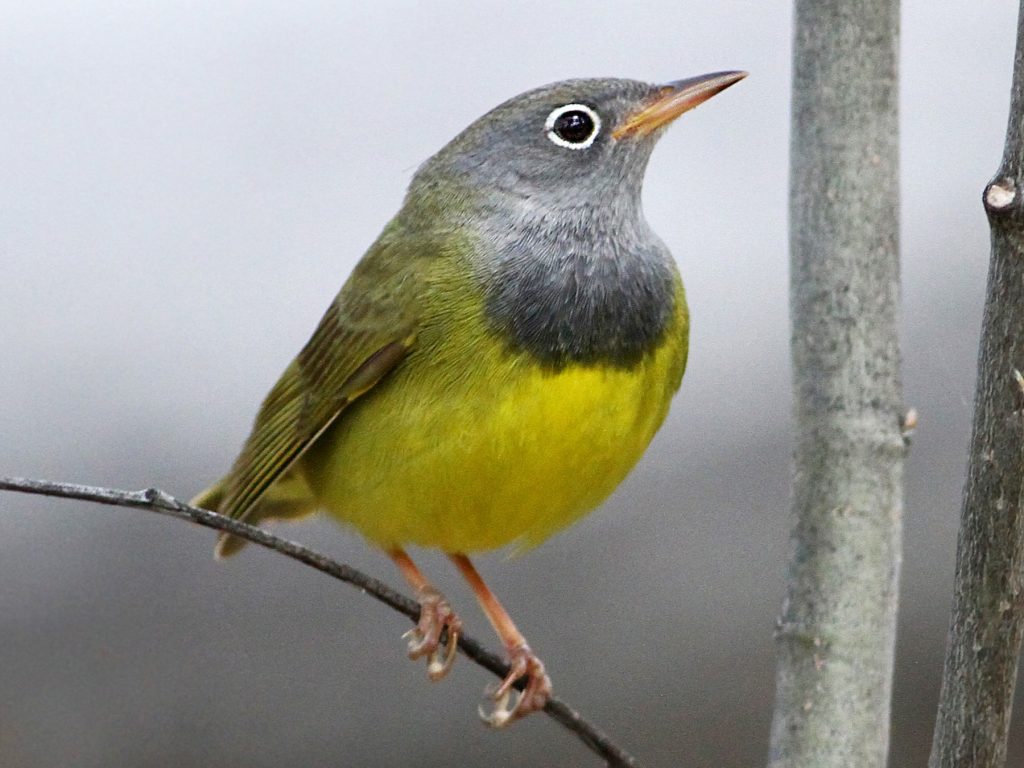
The Connecticut Warbler graces Tennessee during its migratory journeys, captivating observers with its presence during the spring and fall migrations.
Connecticut Warblers exhibit a charming combination of olive and gray plumage. Males feature an olive-green head, back, and wings, contrasted by a gray throat and underparts. Their faces exhibit a distinctive yellow eye-ring. Females possess a more subdued appearance with a paler yellow hue on their underparts and a grayish-olive coloration on their upperparts.
Oporornis agilis
Length: 5.1-5.5 in (13-14 cm)
Weight: 0.4-0.5 oz (11-14 g)
Wingspan: 7.9-8.7 in (20-22 cm)
These migratory songbirds breed in the boreal forests of Canada before embarking on a remarkable journey to their wintering grounds in northern South America.
Spot Connecticut Warblers in dense undergrowth and shrubby habitats, as they diligently search for insects, particularly during migration.
Immerse yourself in the melodious songs of the Connecticut Warbler, adding a harmonious touch to the avian chorus.
Fun Fact: The Connecticut Warbler is known for its secretive nature, often skulking through dense vegetation, making it a challenging species to spot and observe.
27. American Redstart
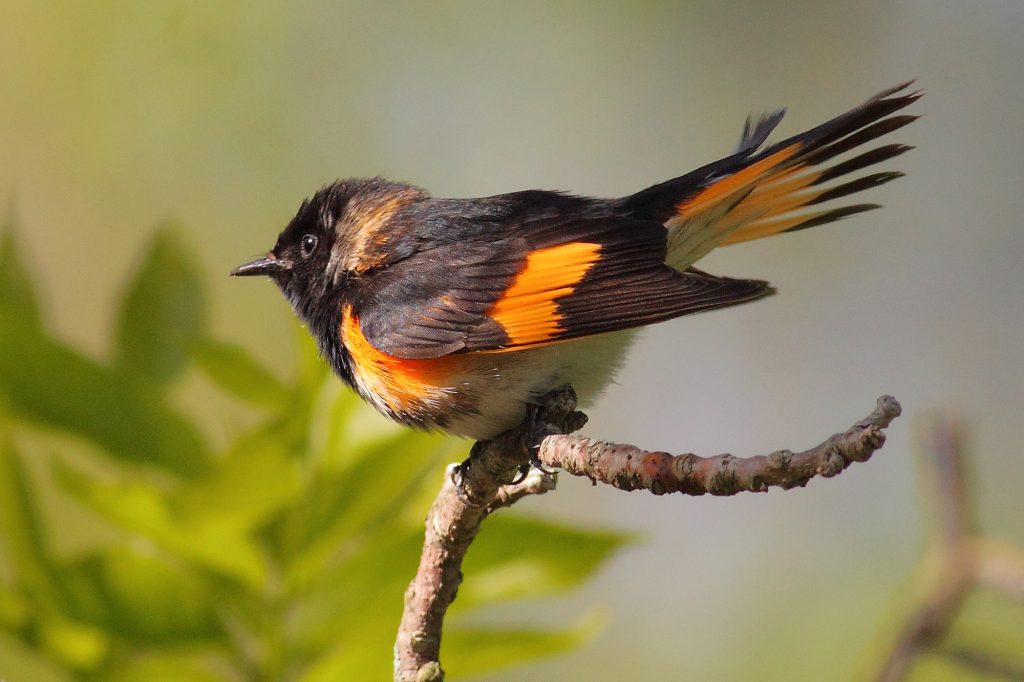
The American Redstart graces Tennessee during its migratory journeys, enchanting observers with its vibrant appearance during the spring and fall migrations.
American Redstarts showcase a captivating combination of black, orange, and white plumage. Males feature a black back, wings, and throat, contrasted by bright orange patches on their sides, belly, and tail. Their tails are often held fanned out, displaying the striking orange coloration. Females possess a more subdued appearance with olive-green upperparts and yellowish underparts.
Setophaga ruticilla
Length: 4.3-5.1 in (11-13 cm)
Weight: 0.3-0.4 oz (8-11 g)
Wingspan: 7.5-8.3 in (19-21 cm)
These migratory wonders breed in the eastern United States and Canada before embarking on a journey to their wintering grounds in Central and northern South America.
Spot American Redstarts in various habitats, including deciduous forests, as they actively forage for insects, often flitting and fluttering their wings while capturing prey.
Indulge in the melodious songs of the American Redstart, a true delight for bird enthusiasts.
Fun Fact: The American Redstart is known for its unique foraging behavior known as “gleaning.” It actively searches for insects on foliage by spreading its wings and tail, exposing the orange patches, which startles and flushes out hidden insects.
28. Magnolia Warbler

The Magnolia Warbler graces Tennessee during its migratory journeys, captivating observers with its striking appearance during the spring and fall migrations.
Magnolia Warblers exhibit a captivating combination of black, yellow, and white plumage. Males feature a black back and wings, contrasted by a bright yellow throat, breast, and belly. Their faces exhibit a distinctive black mask. Females possess a more subdued appearance with olive-green upperparts and yellowish underparts.
Setophaga magnolia
Length: 4.3-4.7 in (11-12 cm)
Weight: 0.3-0.4 oz (8-11 g)
Wingspan: 7.1-7.9 in (18-20 cm)
These migratory wonders breed in the boreal forests of Canada before embarking on an incredible journey to their wintering grounds in Central and northern South America.
Spot Magnolia Warblers in various habitats, including coniferous and mixed forests, as they diligently forage for insects, often hovering to catch their prey.
Immerse yourself in the melodious songs of the Magnolia Warbler, adding a harmonious touch to the avian chorus.
Fun Fact: The Magnolia Warbler is named not after the magnolia tree, but after French botanist Pierre Magnol, who made significant contributions to the field of botany.
29. Cape May Warbler
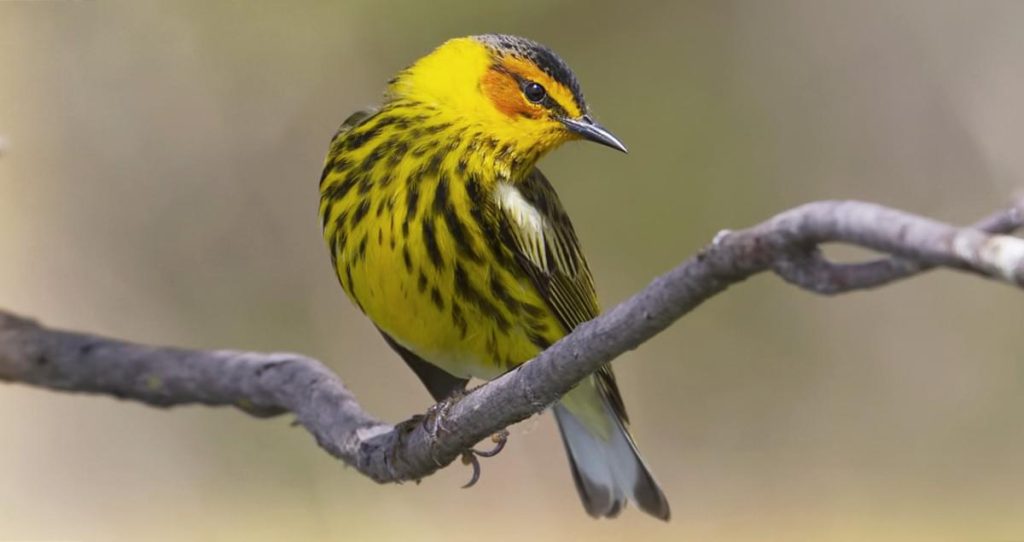
The Cape May Warbler graces Tennessee during its migratory journeys, enchanting observers with its appearance during the spring and fall migrations.
Cape May Warblers showcase a captivating combination of yellow, olive, and chestnut plumage. Males feature a yellow head, chest, and belly, contrasted by olive-green upperparts. Their faces exhibit a distinctive chestnut cheek patch. Females possess a more subdued appearance with a paler yellow hue on their underparts and a grayish-olive coloration on their upperparts.
Setophaga tigrina
Length: 4.3-4.7 in (11-12 cm)
Weight: 0.3-0.4 oz (8-11 g)
Wingspan: 7.1-7.9 in (18-20 cm)
These migratory songbirds breed in the boreal forests of Canada before embarking on an incredible journey to their wintering grounds in the Caribbean and northern South America.
Spot Cape May Warblers in various habitats, including coniferous forests and forest edges, as they diligently search for insects, particularly sipping nectar from flowers during migration.
Indulge in the melodious songs of the Cape May Warbler, a true delight for bird enthusiasts.
Fun Fact: The Cape May Warbler relies on a unique food source during migration—tree sap. They use their specialized tongue to lap up the sugary sap from damaged trees, supplementing their insect diet.
30. Bay-breasted Warbler
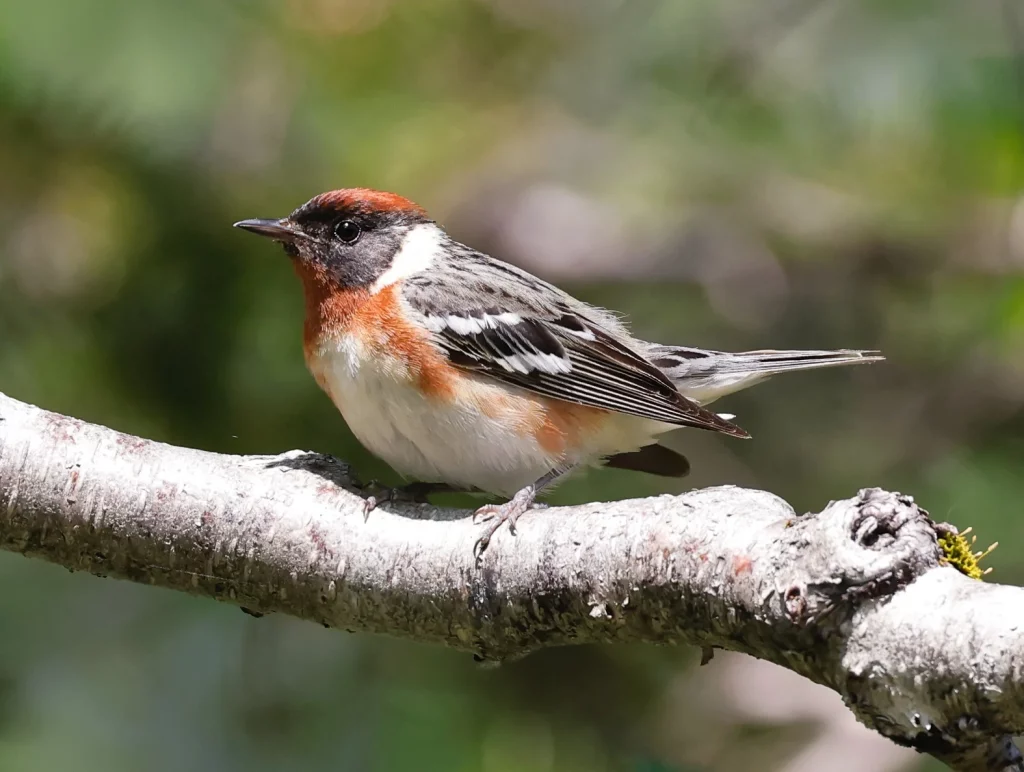
The Bay-breasted Warbler graces Tennessee during its migratory journeys, captivating observers with its presence during the spring and fall migrations.
Bay-breasted Warblers exhibit a charming combination of chestnut, black, and gray plumage. Males feature a chestnut-colored head, back, and sides, contrasted by black streaks on their flanks and gray underparts. Females possess a more subdued appearance with a paler chestnut hue on their head and sides and a grayish-olive coloration on their upperparts.
Setophaga castanea
Length: 4.3-4.7 in (11-12 cm)
Weight: 0.3-0.4 oz (8-11 g)
Wingspan: 7.1-7.9 in (18-20 cm)
These migratory wonders breed in the boreal forests of Canada before embarking on an incredible journey to their wintering grounds in northern South America.
Spot Bay-breasted Warblers in various habitats, including coniferous and mixed forests, as they diligently forage for insects, often searching for them on tree branches and foliage.
Immerse yourself in the melodious songs of the Bay-breasted Warbler, adding a harmonious touch to the avian chorus.
Fun Fact: The Bay-breasted Warbler undergoes a unique molt during the fall migration, replacing its chestnut-colored feathers with gray plumage. This molt helps them camouflage better in their wintering grounds.
31. Blackpoll Warbler

The Blackpoll Warbler graces Tennessee during its migratory journeys, enchanting observers with its appearance during the spring and fall migrations.
Blackpoll Warblers showcase a captivating combination of black, white, and gray plumage. Males feature a black cap and sides, contrasted by a white belly and grayish upperparts. Their faces exhibit a distinctive black mask. Females possess a more subdued appearance with a paler gray hue on their upperparts and a white underparts.
Setophaga striata
Length: 4.7-5.1 in (12-13 cm)
Weight: 0.3-0.4 oz (8-11 g)
Wingspan: 7.5-8.3 in (19-21 cm)
These migratory wonders breed in the boreal forests of Canada before embarking on an incredible journey to their wintering grounds in northern South America.
Spot Blackpoll Warblers in various habitats, including coniferous forests and forest edges, as they diligently forage for insects, often gleaning them from foliage and branches.
Indulge in the melodious songs of the Blackpoll Warbler, a true delight for bird enthusiasts.
Fun Fact: The Blackpoll Warbler undertakes one of the most remarkable migration journeys of any North American songbird. They fly non-stop for over 1,800 miles (2,900 km) across the Atlantic Ocean from the northeastern United States or Canada to reach their wintering grounds in South America.
32. Blackburnian Warbler
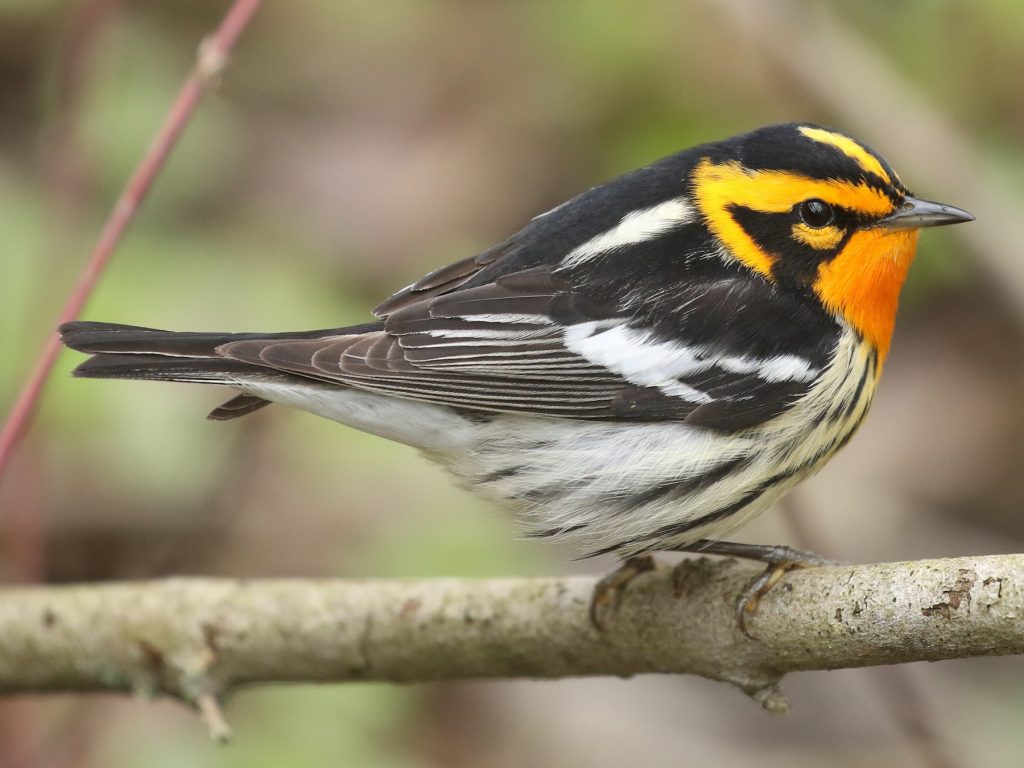
The Blackburnian Warbler graces Tennessee during its migratory journeys, captivating observers with its striking appearance during the spring and fall migrations.
Blackburnian Warblers exhibit a captivating combination of black, orange, and white plumage. Males feature a black back and wings, contrasted by a vibrant orange throat and belly. Their faces exhibit a distinctive black mask. Females possess a more subdued appearance with olive-green upperparts and yellowish underparts.
Setophaga fusca
Length: 4.3-4.7 in (11-12 cm)
Weight: 0.3-0.4 oz (8-11 g)
Wingspan: 7.1-7.9 in (18-20 cm)
These migratory songbirds breed in the northeastern United States and Canada before embarking on a journey to their wintering grounds in Central and northern South America.
Spot Blackburnian Warblers in various habitats, including coniferous forests and high-elevation forests, as they actively forage for insects, often hopping along branches and foliage.
Immerse yourself in the melodious songs of the Blackburnian Warbler, adding a harmonious touch to the avian chorus.
Fun Fact: The Blackburnian Warbler is named after Anna Blackburne, an English botanist who was known for her interest in botany and her contributions to the study of birds.
33. Chestnut-sided Warbler
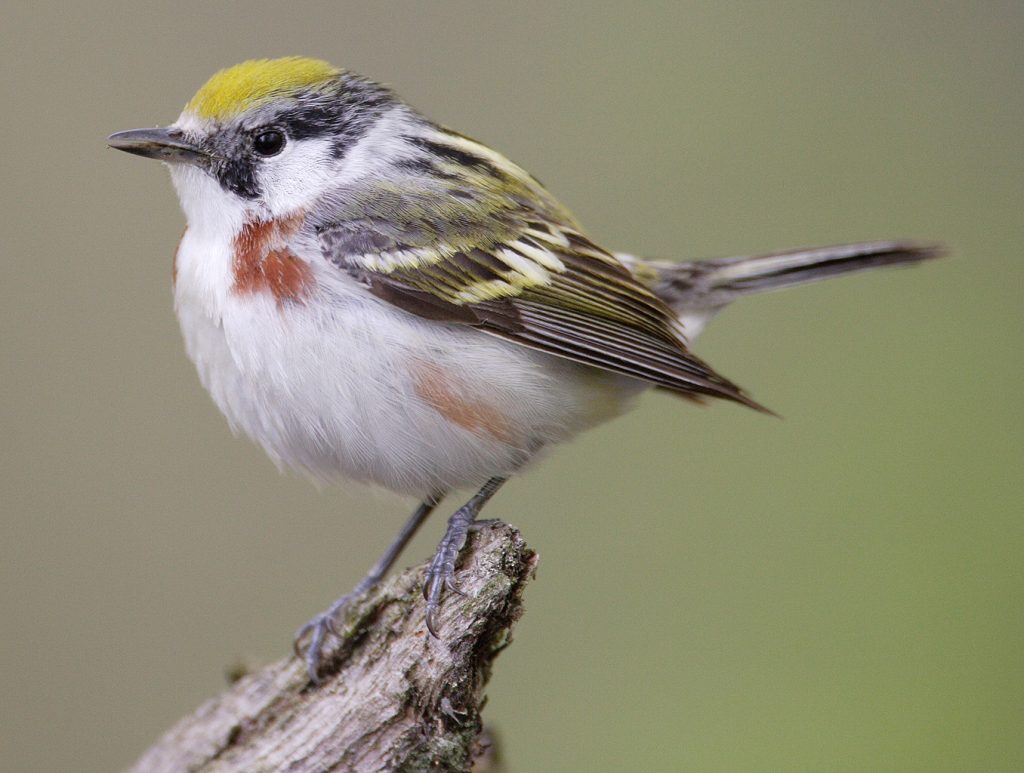
The Chestnut-sided Warbler graces Tennessee during its migratory journeys, enchanting observers with its appearance during the spring and fall migrations.
Chestnut-sided Warblers showcase a charming combination of yellow, chestnut, and gray plumage. Males feature a bright yellow crown and underparts, contrasted by chestnut streaks on their sides and gray upperparts. Females possess a more subdued appearance with a paler yellow hue on their underparts and a grayish-olive coloration on their upperparts.
Setophaga pensylvanica
Length: 4.3-4.7 in (11-12 cm)
Weight: 0.3-0.4 oz (8-11 g)
Wingspan: 7.1-7.9 in (18-20 cm)
These migratory wonders breed in the northeastern United States and Canada before embarking on an incredible journey to their wintering grounds in Central and northern South America.
Spot Chestnut-sided Warblers in various habitats, including deciduous forests and forest edges, as they actively forage for insects, often perching on shrubs and lower branches.
Indulge in the melodious songs of the Chestnut-sided Warbler, a true delight for bird enthusiasts.
Fun Fact: The Chestnut-sided Warbler is often referred to as the “Bandit Warbler” due to the distinctive black mask-like streaks on its face, resembling a bandit’s mask.
34. Palm Warbler
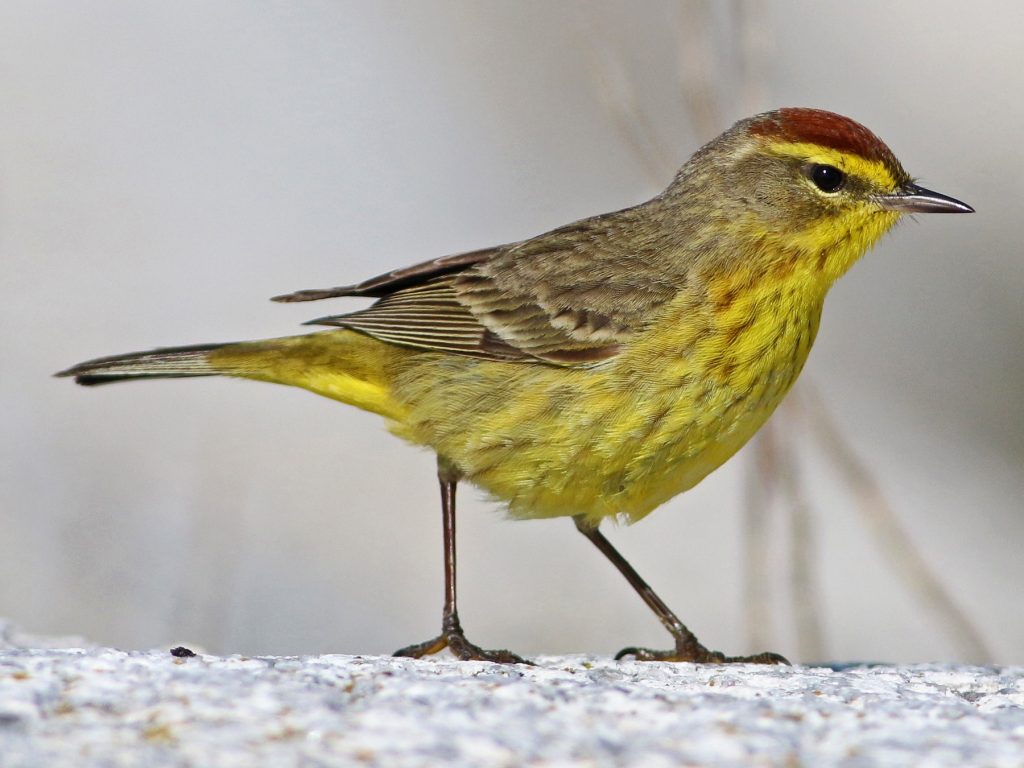
The Palm Warbler graces Tennessee during its migratory journeys, captivating observers with its presence during the spring and fall migrations.
Palm Warblers exhibit a charming combination of brown, yellow, and gray plumage. They showcase two distinct plumage variations known as the “Western” and “Yellow” Palm Warblers. The Western Palm Warblers feature a brown back, yellow underparts, and a rusty cap. The Yellow Palm Warblers display a bright yellow undertail and rump.
Setophaga palmarum
Length: 4.7-5.1 in (12-13 cm)
Weight: 0.3-0.4 oz (8-11 g)
Wingspan: 7.5-8.3 in (19-21 cm)
These migratory songbirds breed in the boreal forests of Canada and Alaska before embarking on a journey to their wintering grounds in the southeastern United States, Caribbean, and Central America.
Spot Palm Warblers in various habitats, including open woodlands, wetlands, and grassy areas, as they actively forage for insects and occasionally forage on the ground, wagging their tails.
Immerse yourself in the melodious songs of the Palm Warbler, adding a harmonious touch to the avian chorus.
Fun Fact: The Palm Warbler gets its name not from palm trees but from its tendency to forage in low vegetation, including palm trees, during the winter months.
35. Nashville Warbler
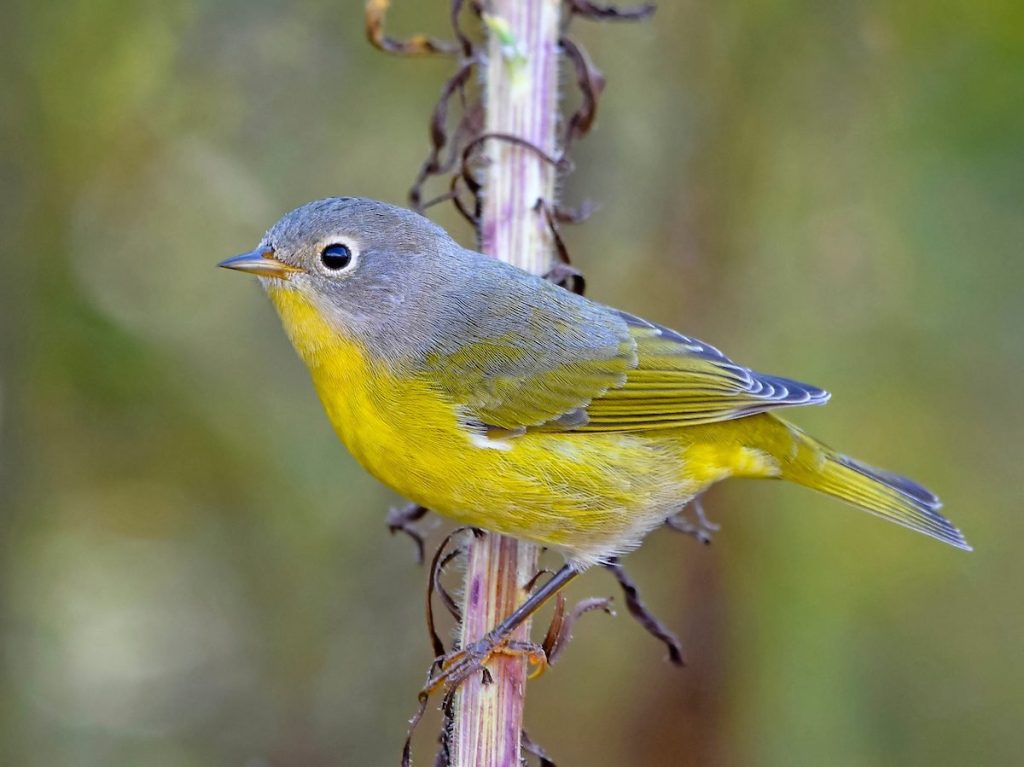
The Nashville Warbler graces Tennessee during its migratory journeys, enchanting observers with its appearance during the spring and fall migrations.
Nashville Warblers exhibit a charming combination of yellow, gray, and olive plumage. They feature a bright yellow underparts, a gray head, back, and wings, and olive-green upperparts.
Leiothlypis ruficapilla
Length: 4.3-4.7 in (11-12 cm)
Weight: 0.3-0.4 oz (8-11 g)
Wingspan: 7.1-7.9 in (18-20 cm)
These migratory wonders breed in the boreal forests of Canada and the northeastern United States before embarking on an incredible journey to their wintering grounds in Central and northern South America.
Spot Nashville Warblers in various habitats, including mixed forests, shrubby areas, and woodland edges, as they actively forage for insects, often gleaning them from leaves and branches.
Indulge in the melodious songs of the Nashville Warbler, a true delight for bird enthusiasts.
Fun Fact: The Nashville Warbler was named by Alexander Wilson, who encountered this species near Nashville, Tennessee, during his bird studies in the early 19th century.
36. Northern Parula

The Northern Parula graces Tennessee during its migratory journeys, captivating observers with its striking appearance during the spring and fall migrations.
Northern Parulas exhibit a captivating combination of blue, yellow, and gray plumage. Males feature a bluish-gray back, wings, and throat, contrasted by a bright yellow throat and underparts. Their faces exhibit a distinctive white eye crescent. Females possess a more subdued appearance with a paler yellow hue on their underparts and a grayish-olive coloration on their upperparts.
Setophaga americana
Length: 4.3-4.7 in (11-12 cm)
Weight: 0.3-0.4 oz (8-11 g)
Wingspan: 7.1-7.9 in (18-20 cm)
These migratory songbirds breed in the eastern United States and Canada before embarking on a journey to their wintering grounds in Central and northern South America.
Spot Northern Parulas in various habitats, including deciduous and mixed forests, as they actively forage for insects, often hanging upside down and fluttering their wings while capturing prey.
Immerse yourself in the melodious songs of the Northern Parula, adding a harmonious touch to the avian chorus.
Fun Fact: The Northern Parula constructs one of the most exquisite nests among North American songbirds. The nest is often built in a hanging moss or lichen-covered tree branch, providing camouflage and protection for their young.
37. Prairie Warbler
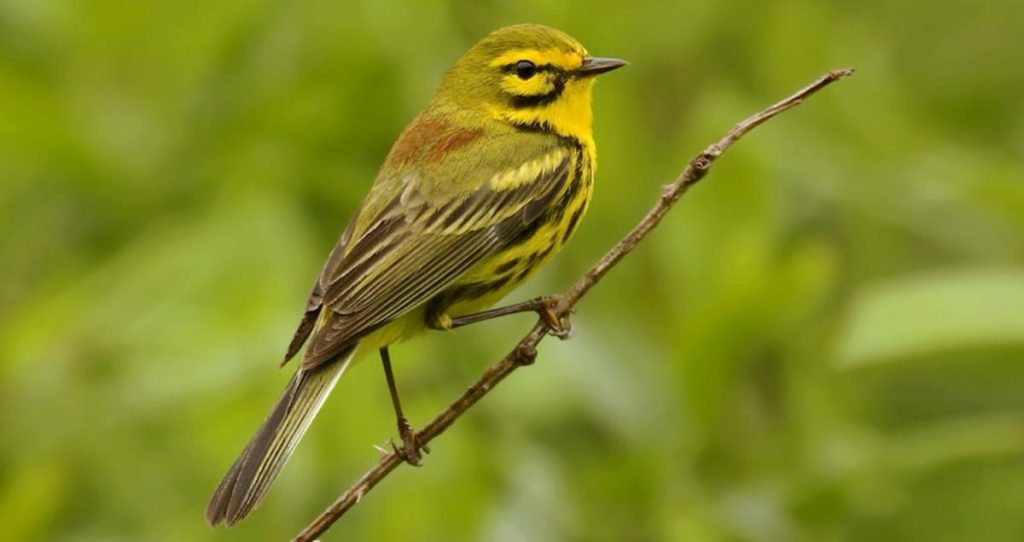
The Prairie Warbler graces Tennessee during its migratory journeys, enchanting observers with its appearance during the spring and fall migrations.
Prairie Warblers showcase a charming combination of yellow, olive, and black plumage. Males feature a bright yellow throat, breast, and belly, contrasted by black streaks on their sides and olive-green upperparts. Females possess a more subdued appearance with a paler yellow hue on their underparts and a grayish-olive coloration on their upperparts.
Setophaga discolor
Length: 4.3-4.7 in (11-12 cm)
Weight: 0.3-0.4 oz (8-11 g)
Wingspan: 7.1-7.9 in (18-20 cm)
These migratory wonders breed in the eastern United States and Canada before embarking on an incredible journey to their wintering grounds in the Caribbean and Central America.
Spot Prairie Warblers in various habitats, including shrubby areas, young forests, and pine barrens, as they actively forage for insects, often flitting and hovering to catch their prey.
Indulge in the melodious songs of the Prairie Warbler, a true delight for bird enthusiasts.
Fun Fact: The Prairie Warbler is often referred to as the “Prairie Yellowthroat” due to its habitat preferences and bright yellow throat.
Guide to Warbler Songs
The melodious tunes of warblers often precede their visual presence, and if you familiarize yourself with a few of their melodies, it becomes easier to identify the feathered creatures you encounter. Fortunately, some warblers possess songs that are more distinctive than others.
The songs of warblers can be described as either buzzy, clear, or trilling, and they exhibit various auditory elements. A buzzy note resembles the sound of an insect, a clear note resembles a whistle, and a trill is a rapid sequence of notes that merge into an indistinguishable blur.
Within this guide, you have the opportunity to listen to the songs of all the warblers mentioned. Additionally, you can explore this comprehensive compendium consisting of 13 recognizable warbler songs for assistance.
Warblers with Buzzy Songs:
– The song of the Black-throated Blue Warbler rises with a buzzy tone.
– Prairie Warblers also produce buzzy and rising songs.
– Black-throated Green Warblers create buzzy songs with a couple of clear notes in the middle.
– Blackpoll Warblers emit clear and steady songs that resemble the buzz of an insect.
– Prairie Warblers produce buzzy songs that rise in pitch.
– Palm Warblers generate buzzy melodies.
Warblers with Songs Featuring Clear Notes:
– Common Yellowthroats sing a series of rising and falling notes that are repeated.
– Ovenbirds deliver a sequence of notes that ascend and descend.
– Hooded Warblers produce distinct and clear notes.
– Chestnut-sided Warblers have songs consisting of a series of clear descending notes that accelerate towards the end.
– Yellow-rumped Warblers create a series of clear notes that gradually fade away.
– Yellow Warblers’ songs gradually increase in tempo.
– Northern Parulas possess a rising trill that concludes with a different note, akin to a punctuation mark denoting cessation.
– Wilson’s Warblers emit songs comprised of a series of clear descending notes that accelerate.
The Frequency of Warbler Sightings in Tennessee During Summer and Winter
Checklists serve as an invaluable resource to determine the common avian inhabitants of your state. These compilations provide insights into which warblers are most frequently observed during summer and winter in Tennessee, as recorded on eBird checklists.
Warblers in Tennessee During Summer:
– Common Yellowthroat: 17.8%
– Yellow-breasted Chat: 13.9%
– Northern Parula: 13.5%
– Prothonotary Warbler: 8.0%
– Hooded Warbler: 7.9%
– Yellow-throated Warbler: 7.0%
– Kentucky Warbler: 6.3%
– Prairie Warbler: 6.0%
– Black-and-white Warbler: 6.0%
– American Redstart: 5.7%
– Black-throated Green Warbler: 5.4%
– Ovenbird: 5.1%
– Louisiana Waterthrush: 4.8%
– Pine Warbler: 4.5%
– Tennessee Warbler: 4.3%
– Yellow Warbler: 4.2%
– Chestnut-sided Warbler: 4.0%
– Blackpoll Warbler: 3.7%
– Magnolia Warbler: 3.4%
– Yellow-rumped Warbler: 3.2%
– Worm-eating Warbler: 2.8%
– Palm Warbler: 2.5%
– Bay-breasted Warbler: 2.4%
– Blackburnian Warbler: 2.0%
– Canada Warbler: 1.6%
– Cerulean Warbler: 1.6%
– Black-throated Blue Warbler: 1.3%
– Cape May Warbler: 1.3%
– Northern Waterthrush: 1.2%
– Swainson’s Warbler: 1.1%
– Blue-winged Warbler: 1.1%
– Nashville Warbler: 1.0%
– Wilson’s Warbler: 0.5%
– Golden-winged Warbler: 0.5%
– Mourning Warbler: 0.4%
– Connecticut Warbler: 0.2%
– Orange-crowned Warbler: <0.1%
Warblers in Tennessee During Winter:
– Yellow-rumped Warbler: 21.2%
– Pine Warbler: 4.0%
– Palm Warbler: 1.3%
– Orange-crowned Warbler: 1.1%
– Common Yellowthroat: 0.1%
– Yellow-breasted Chat: 0.1%
– Cape May Warbler: <0.1%
– Northern Parula: <0.1%
– Yellow-throated Warbler: <0.1%
– American Redstart: <0.1%
– Nashville Warbler: <0.1%
– Black-and-white Warbler: <0.1%
– Canada Warbler: <0.1%
– Tennessee Warbler: <0.1%
– Blue-winged Warbler: <0.1%
– Yellow Warbler: <0.1%
– Chestnut-sided Warbler: <0.1%
– Magnolia Warbler: <0.1%
– Wilson’s Warbler: <0.1%
– Prairie Warbler: <0.1%
– Hooded Warbler: <0.1%
– Black-throated Green Warbler: <0.1%
– Northern Waterthrush: <0.1%
– Ovenbird: <0.1%
– Louisiana Waterthrush: <0.1%
– Black-throated Blue Warbler: <0.1%
How to Attract Warblers to Your Backyard
Although warblers are not as commonly attracted to backyard feeders as other songbirds, there are measures you can take to invite these melodious creatures to your premises:
- If your yard is spacious enough, provide trees.
- Leave brush piles intact and embrace a slightly untidy environment to create suitable habitats for insects, which in turn attract birds.
- Avoid the use of pesticides and herbicides to ensure an abundant insect population for the birds without any harmful consumption.
- Ensure a clean water source is available.
- Offer mealworms, preferably live ones, or dried ones if live ones are unavailable.
- Supply bird feeders with sunflower seeds, peanut hearts, and suet.
